165 World War 1 Topics for Essays with Examples
Looking for good World War 1 topics to write about? This area of study is exciting, controversial, and worth analysing!
- 🔝 Top 10 WW1 Topics to Write about
- 📝 WW1 Essay: How to Write
- 🏆 Best WW1 Essay Topics & Examples

💡 Good Essay Topics on WW1
- 🔎 Interesting Topics to Write about WW1
- ⭐ WW1 Research Topics
- 📃 Simple & Easy WW1 Essay Titles
- ❓ WW1 Essay Questions
In your WW1 essay, you might want to focus on the causes of the conflict, its participants, or answer the question of who started the First World War. In this article, we’ve gathered 139 WW1 ideas that you can use in any project, presentation, or even debate. There are also great World War 1 essay examples to inspire you even more.
🔝 Top 10 World War 1 Topics to Write about
- Causes of World War I
- Political and military alliances before the WWI
- Assassination of Archduke Franz Ferdinand as the starting point of WW1
- Naval warfare of World War I
- Ottoman Empire in World War 1
- The role of technology in World War 1
- The use of chemical weapons in WWI
- The most cruel war crimes of WW1
- Armenian genocide as a part of World War 1
- The effects and consequences of WW1
📝 World War 1 Essay: How to Write
With over 60 million people mobilized and involving countries all around the world, any World War 1 Essay is bound to touch upon a wide variety of topics.
The mechanics behind the start of the war, its process, and results all interconnect, which may make the subject seem hard to understand and harder to outline.
However, navigating your way around World War 1 essay questions is only a matter of taking note of a few cornerstone historical processes.
Before You Start Your Outline
Do some research on your assigned issue. The more books and journals you peruse, the more aware of your subject you will be. You will not use all of them, but you will form an understanding of which titles your essay needs.
As you continue your research, start compiling your bibliography, which will be the backbone of your essay’s credibility. World War 1 is a highly historiographical event, and you will be sure to find a wide variety of literature on it on the internet.
Write down some essential terms and think about how they relate to your essay. Imperialism, nationalism, the Versailles treaty are good starter examples of omnipresent processes and results of World War 1. Doing so may help you give your essay a new, previously explored perspective.
Structuring your Thoughts into an Essay Outline
After you have finished with your sources and key terms, think about how you can split your main theme into subtopics.
Even if your essay is a single page, doing so will allow you to divide your ideas evenly between paragraphs. If it is on the longer side, think about including subheadings in your work.
This action gives your essay a more rigid structure that is easy to read. Additionally, now is the time to think about your essay’s title. World War 1 essay titles should reflect your stance as the writer and hint at the conclusion that you will draw.
You may feel like your outlined subheadings are overlapping, making your essay seem messy. In this case, find and read a World War 1 essay sample. Plagiarism is a severe academic offense, but getting inspired by someone else’s work, while giving credit, is not.
Beginning to Write
You should try to start your essay with something that attracts the attention of your readers. This World War 1 essay hook can be a fact or an intriguing explanation of a process central to your topic. Then, in this paragraph:
- Give your readers a brief overview of the events that are relevant to your essay;
- Hint at your intent, explain your methods and make your point of view clear;
- Make sure your readers are aware of what problems you will touch upon;
- Create a working thesis statement that will be your guideline throughout your work.
Each paragraph you include should link back to your thesis statement. Always be sure to ask yourself when writing:
- Does this further my argument?
- Can my facts be used against me? How can I fix that?
- Is there a different perspective on this issue?
- Could I remove this without hurting the quality of my essay?
- Is my structure reflective of the problem it is covering? What can I do better?
Remember that a good structure reflects the amount of effort you put into your work. Need a sample to get inspired? Head over to IvyPanda!
🏆 Best World War 1 Essay Topics & Examples
- First World War: Causes and Effects This later led to the entry of countries allied to Serbia into the war so as to protect their partners. In conclusion, the First World War led to the loss of many lives.
- Positive and Negative Effects of WW1 on Canada: Essay Nonetheless, the war led to great negative impacts such as loss of lives, economic downtrend, and the generation of tensions involving the Francophones and Anglophones who disagreed after the emergence of the notion of conscription.
- Effects of the Industrial Revolution in Relation to World War I During the last period of the 19th century all the way to the early 20th century, Europe and America experienced revolutions in communication, transportation and weapons which were very crucial particularly in the manner in […]
- American Dream After World War I People lost vision of what this dream was supposed to mean and it became a dream, not of the vestal and industrious, but of the corrupt coterie, hence corrupting the dream itself.
- Ernest Hemingway’s Personality and His Reflections on WWI The events of World War I and Hemmingway’s personal experiences seemed to have an impact on his writings as he sought to establish himself alongside great writers in the Lost Generation, thus portraying his sensitivity.
- World War I Technology Although the question of the origins of the Great War is highly debated, and although this war is considered by many as the beginning of a new stage in history and the real starting point […]
- Federal Government Expansion During World War I The period between 1914 and 1918 was marked by the increased role of the federal government in the United States and the dramatic expansion of its bureaucracies.
- Total War of World War I The paper will demonstrate that the First World War was a total war since it bore most the hallmark characteristics of the total war including unlimited warfare, prioritization of armament efforts, involvement of the civilian […]
- The Second Battlefield: Women, Modernism, and the First World War The first theme is the connection of writings of women on the subject of the First World War and the modernism theoretical constructs.
- The Causes and Effects of World War I To this end, the Commission on the Responsibility of the Authors of the War and the Enforcement of Penalties met in Paris in 1919. It is impossible to name a single reason for the initiation […]
- Anti-War Movement DADA Vs. Propaganda Posters of WWI In relation to the causes of the WWI, these can considered as pertinent specifically on the basis that the reasons can be related to the type of society that is present during the said era.
- Causes of WWI and WWII: Comparing and Contrasting In the following paper, Kenneth Waltz’s levels of analysis will be used for the comparison and contrast of causes of WWI and WWII. The second similarity refers to the distribution of power and the division […]
- The Book “The First World War” by John Keegan However, the emergence of the bill of the right to people’s life across the globe is owed to the occurrence of the First and the Second World War.
- World War 1 Origins (How and Why the War Started) William Anthony Hay claims that according to McMeekin, a tutor of international relations, “The war’s real catalyst lay in Russia’s ambition to supplant the waning Ottoman Empire in the Near East and to control the […]
- The Aftermath of World War I for Germany In spite of the fact that Germany was one of the most powerful European states before the war’s start in 1914, World War I led to the political, economic, and social decline in the country […]
- The Progressive Era and World War I To achieve the intended goals, many progressives began by exposing the major evils and challenges that were affecting the United States towards the end of the 19th century.
- Life of Soldiers During the World War I In this paper, we are going to discuss how the World War I affected live of people and what was the life of soldiers and civilians serving and living on the frontlines.
- Causes and Consequences of World War 1 In social and economic cycles, the interaction of the whites and Blacks was controlled by the laws that neither of the groups was allowed to cross the other party’s path.
- The Progressive Movement and the American Entry Into World War I The motivations of the progressive movement were complex and varied, but they all sought to improve the lives of the people of the United States.
- World War I as the Catastrophe of the 20th Century There were increased cataclysms in Europe over time; for instance, the war laid a foundation for the rise of Hitler and increased the influence of the Nazism ideology.
- World War I: American Policy of Neutrality Even though the people of America were shocked and firmly against involvement in the war, the US president thought of the crisis as a turning point that could significantly change America’s place in the world.
- Economic Causes of World War I As of 1860, the American South was generating 75% of the world’s cotton due to the institution of slavery on the part of its wealthy farmers.
- The Role of Canada in World War I The beginning of the war was marked by great losses in the field and in the economy of the state. By the war’s end, Canada had shown itself as a great power, which allowed the […]
- America’s Progressive Era and World War I This paper will outline the events leading to America’s entrance into the war, the obstacles faced by the U.S.military, and the role of American women and minorities.
- Aboriginal Soldiers in the World War I and II Additionally, the paper will argue that the role and experiences of Aboriginal soldiers and the manner in which they have been overshadowed by other significant events in Australian history.
- The Entry of the United States Into World War I The United States is believed to have entered the war after sinking the American liner Lusitania by a German submarine in 1915. Due to the competent actions of President W.
- Role the United States of America in the World War I The main result of the battle was the victory of the Entente and the collapse of the four largest empires: the Russian, Austro-Hungarian, Ottoman, and German.
- Impact of World War I on the American Army Some of the major strategies include the use of airplanes in the field of battle, employing armored vehicles, and electronic communication.
- America’s Involvement in World War I The issues that led to America’s involvement in this were the German’s resumption of unexpected submarine attacks and the Zimmerman telegram.
- The United States Priorities Following World War I Gentile, Linick, and Shurkin single out four important periods in the evolution of the US army: Constitutional moorings and the 19th century, the Spanish-American War to Total War, and the Korean War to Total Force […]
- Biggest Influence on the US Involvement in World War I Although a combination of factors including trade alliances and the interception of the Zimmerman note encouraged the decision to join the fray, Germany’s unrestricted submarine warfare was the biggest reason for the US involvement.
- Nationalism in Europe Before WWI This movement was the result of effective propaganda and an aggressive policy aimed at the redistribution of territories and the seizure of power.
- Factors Leading to the Termination of World War I However, the deliberate humiliation of the German leadership at the hand of the Allied forces perpetrated through the signing of the “war guilt clause” indicates that the reason for the Allied forces was not solely […]
- World War I Causes by Ethnic Problems in Austro-Hungary The presence of the heir to the Austro-Hungarian throne in the said maneuvers was the perfect opportunity. After the capture of Gavrilo Princip it was time for the Austro-Hungarian Empire to react and teach the […]
- World War I: Medias of Propaganda in the U.S. Posters of World War 1 presented a different style of propaganda because of the war time effort of U S government.
- America Changes After World War I Among the various changes underwent by America during their recovery period in the 1920s were changes in culture, economy as well as in the workforce.
- America in World War I One of the events that led America into the First World War was when a liner belonging to the British was sunk by the U-boat belonging to Germans.
- The Nature of the Fighting in World War I and World War II So, the results of this war were awful, but still, speaking about the losses of the World War II, it can be said, that it was the bloodiest conflict in human history. The most obvious […]
- Treaty of Versailles History: The Pact of Peace After WWI The differences among the winners of the war, later on, led to the emergence of more conflicts simply because Germany was not fully weakened; it is believed that the conflicts between these nations were the […]
- The Wars Between 1815 and WWI in Europe Tsar Nicholas moved into Moldavia and Wallachia and secret accords with the Austrian and British governments for the disposition of the Ottoman empire were formulated in 1844 in London.
- World War I Within the Context of Military Revolution The main peculiarity of the World War I is the advent of the so-called “three-dimensional conflict”, which means that the combat is held also in the air.
- Life Before World War I and Life of Soldiers in Trenches The future of these Habsburg domains, assembled over the centuries by marriage, purchase and conquest, was the subject of endless coffee-table speculation, but the subsequent demise of the monarchy should not necessarily encourage the notion […]
- Great Depression of Canada and Conscription During World War I in Canada Due to the depression in the United States, the people across the border were not able to buy the wheat produced and cultivated in Canada and as a result, the exports declined.
- Leadership in the World War I Environment Military leadership is the process of influencing others to accomplish the mission by providing purpose, direction, and motivation and the basic responsibilities of a leader are the accomplishments of the mission and the welfare of […]
- World War 1 and Technological Improvement The was sparked by the assassination of the Heir to the Austrian throne, Franz Ferdinand by a Serbian nationalist, Gavrilo Princip on June 28th, 1914.
- The Battle of Verdun: World War One The choice of Verdun as the center of interest by the Germans was not very effective because the French men lost faith in the fortresses and the need to defend them.
- Imperialist Global Order After World War I Thus, the general trend of the after-war years was the dismantling of multiethnic empires and the establishment of new nation-states. However, World War I also created new challenges to the existing hierarchies of wealth and […]
- Soccer Influence on Sociopolitical Aspects of WWI During this period, many footballers and athletes were tempted or encouraged to join the militaries of their respective countries and become part of the ongoing war.
- Idealist Philosophy After World War I Although I disagree with the philosophy of idealism, it is a fact that it managed to create a better world following the events of World War I.
- World War I and Its Outbreak Causes Some of the events that influenced the eruption of World War I include the Franco-Prussian war, the Moroccan crisis, the Balkan wars, and the assassination of Archduke Franz Ferdinand from Austria.
- World War I and Battle of Vimy Ridge for Canadians If the authors of the required readings gathered for a discussion of the First World War and Vimy Ridge, they would be likely to agree and disagree with one another on some points.
- Aftermath of the WWI The source concludes that the provisions of the treaty were unfavorable to the government and the people of Germany, something that forced the country’s leaders to respond with militarization of the state.
- Trucial States’ History From World War I to the 1960s During the decline of the pearling industry, the British were highly vigilant to sustain the existing regional trend of alienation amongst leaders and the people.
- World War I and Its Aftermath In 1930, Hitler’s ambitions and the rise of Nazism was boosted by president’s declaration that the state was to be ruled autocratically.
- American Experiences in World War I: Radio Broadcast There was a heated debate in the American society concerning the county’s involvement in the Great War, and President Wilson was heavily criticized not only for the fact of entering the war but also for […]
- World War I and the 1920s In this case, American citizens went from industry workers and soldiers during the World War I to the explorers, who discover different forms of entertainment in the 1920s because of stabilization of the politics in […]
🔎 Interesting Topics to Write about World War 1
- World War I, Its Origin and Allies Many researchers consider the assassination of the heir to the Austro-Hungarian throne, Archduke Franz Ferdinand, in June 1914 in Sarajevo to be the reason for the start of World War I.
- World War I for Americans: Before and After It is important to say that lower classes had to deal with the biggest number of issues, and they have suffered the most.
- France Before World War I and After World War II To overcome the negative consequences of the Franco-Prussian War, France needed to focus on new perspectives for the state’s economic and political development, and such an approach could provide the state with the necessary resources […]
- Pozieres Battle in World War I on Western Front The battle for the village of Pozieres was one of the deadliest and most remarkable for the Australian troops which took part in the First World War.
- Native Americans Role in World War I Most of the students who went to schools away from the reserves came to the realization that they were, ‘first Americans and then indians second.’3 The schools also taught patriotic songs as well as observation […]
- American History From Reconstruction to World War I However, despite the popular opinion of the individual initiative of the first settlers, the federal government played a great role in facilitating the settlement of the West.
- America & World War I The three years have been used to argue that the US was unwilling to enter the war; that the US was neutral as Woodrow Wilson had declared.
- From World War One to Globalization Even though the First World War shook Europe to the core, the combination of the first and the Second World War created a three world order, modeled along three rival political affiliations.
- How the Federal Bureaucracy Expanded During WWI? The role of the bureaucracy was expansive during the war since the state was expected to provide many services to the citizens, something that led to the formulation of stronger rules and regulations to guide […]
- The Expansion of Federal Bureaucracy During WWI With these, a number of government agencies were created during the WWI particularly when it emerged that there was a need to regulate or control industrial sector as well as the call for the US […]
- Role of Civilian Population in World War I Not only did the war encouraged people to join their forces in order to fight the enemy, but also affected their perception of the state’s key political processes raising political engagement rates among population, WWI […]
- Eastman Kodak Company and Fujifilm The Eastman Kodak Company has been focusing on photography and has currently added the use of technology in combining images and information in order to alter the ways through which businesses and people communicate.
- WWI: Germany’s Secret Gambles The “interception of the German arms shipment by the Royal Navy” led to the quick suppression of the Eastern uprising and execution of key leaders of the Irish Republicans.
- Watching the World Fall Apart: A Post-WWI Vision of the World in the Works of Otto Dix, Max Beckmann and George Grosz While it is quite understandable that at the current stage of the development of humankind, some conflicts still have to be resolved with the use of coercive methods, war as a massive homicide still remains […]
- First World War and Germany In particular, the author is more concerned with giving the effects of the war on the German people, unlike other authors who generalize the effects of the war.
- Ernist Junger’s World War I Experiences When the Storm of Steel was published, it became a favorite in Germany since it adored the greatness of war and the huge sacrifices made by the Germany warriors to end the war victoriously.
- World War I Technological Advancements World War I saw the application of several new technologies to the battlefield, the most important being that of the internal combustion engine, which permitted the development of the first successful mechanized armored fighting vehicles1.
- The First World War and the Russian Revolution Scholars argue that Russia’s involvement in the First World War and the economic consequences are the primary causes of the revolution.
- Effects of World War I on the Development of Modern Art For the artists and most of the people in Europe, the time that preceded the World War I, the actual war period and the aftermath of the was presented a period of profound disillusionment 13.
- United States and World War I The paper further gives an in-depth analysis of how the Germans waged war against the European countries and the circumstances that forced the United States to abandon its neutrality to take part in the Great […]
- WWI-War: Revolution, and Reconstruction In as much as soldiers and civilians garnered experience during WWI, it is imperative to acknowledge that the unsuitable environment at the forefront led to deterioration of health standards; furthermore, civilians were forced to live […]
- The Causes of the First World War In his description of the war, it is clear that Europe played a key role towards the formation of the war alliances.
- The Role of Airplanes During World War I (1914-1918) The government further formed a consultative ‘Aircraft Production Board’ that was made up of members of the Army, Navy, as well as the sector to assess the Europeans’ fortunes in aircraft sector in a bid […]
- The World War I The war brought to the fore various issues which had been in the air in the end of the nineteenth century and in the beginning of the twentieth century.
- Importance of Accountability: World War I It is clear from the beginning of this article, that the statistics on the World War I causalities indicates that the Germans suffered fewer casualties compared to their western counterparts, who are the French and […]
- Events Leading Up to WWI This move also contributed to the start of the conflict and eventually to the war. This decision was vehemently opposed by the Slavs, which saw Russia come to the aid of Serbia while on the […]
- America and Democracy, at Home and Abroad, During and Just After the First World War Democracy is a kind of regime in which all eligible citizens are allowed to contribute to the decisions of the state.
- Changes in the Middle East After the World War I The involvement in the war by the countries from the Middle East not only led to loss of power but also spurred the economic decline and created social problems.
⭐ World War 1 Research Topics
- Industrialization and Competition for Resources Which Led to the First World War
- Factors That Made the First World War Unique
- Identify and Evaluate Two Main Themes That Have Defined Management Thought Since the End of the First World War.
- The Events and Results of the First World War I
- Terrible Beauty: Music and Writing of the First World War
- Liberal Democracy and Capitalism After World War 1
- European Politics and the Impact of French Foreign Policy Before the First World War
- Chemical Warfare During the First World War
- The First World War and Russian Revolution
- European Diplomacy and the First World War
- With What Justification Can World War 1 Be Called a Total War
- The Catalyst for the First World War
- The Reasons for the Economic Prosperity in America After the First World War
- Events Leading for the First World War
- Imperialistic Rivalries and the Road to the First World War
- Shaping the American Dream, Defining Success From the First World War to Present
- Austro-Serbian Relations Provoked the First World War
- America and the First World War
- The Purpose and Intent of the League of Nations After the First World War
- The First World War Impact on Australian Economy
- The Long Term and Short Term Causes of World War 1
📃 Simple & Easy World War 1 Essay Titles
- European Goods Market Integration in the Very Long Run: From the Black Death to the First World War
- The Reasons for the American Support for the Involvement in the First World War
- Military Technology During the First World War
- German Foreign Policy and the Impact of Nationalism on It Before the First World War
- The American Foreign Policy After the First World War
- The Economic, Social, and Political Impact of the First World War on Eur
- Technological Advancements During the First World War
- The World Before the First World War According to Barbara Tuchman
- The Effects That the First World War Had on Many People
- The Effective Weapons Used in the First World War
- Women’s Work During the First World War
- Diplomatic Crises: The First World War and the Cuban Missile Crisis
- The First World War Changed the Way People Thought About War and Patriotism
- Gender Roles During the First World War
- The Reasons for the Outbreak of the First World War
- Australia’s Economic and Military Contribution in the First World War
- The First World War: A New Era of Military Conflict
- German Propaganda During the First World War
- Analyzing Propaganda During World War 1
- Britain During the First World War and the Social and Welfare Reforms
❓ World War 1 Essay Questions
- How Important Was the Entry of the U.S. Into the First World War?
- Was the First World War a Total War?
- What Effect Did the First World War Have on Germany?
- How Significant Was the First World War?
- In What Ways Were People’s Lives at Home Affected by the First World War?
- The Russian Revolution Us a Direct Result of the First World War
- How Did Medical Care Change During the First World War?
- How the First World War Created Modern America?
- Was the First World War the Cause of the February Revolution in Russia?
- Was the First World War Inevitable?
- How Did the First World War Change the Role of Women?
- How Industrialization Powered the First World War?
- Why Did the First World War Last So Long?
- How Far Was the First World War Responsible for the Growth of the Labour Party and the Decline of the Liberal Party?
- Why Did the United States Entry Into World War 1?
- How Did the United States Prepare to Fight for the First World War?
- How Did the First World War Set the Global Stage for the Second World War?
- Why Did World War 1 End So Quickly After the Years of Stalemate?
- Why Did the First World War End When It Did?
- How Did the First World War Affect Britain Society?
- How Did Women Affected World War 1?
- How Did Imperialism Cause World War 1?
- How the First World War Impacted the Homefronts of Participating Nations?
- Was the Alliance System the Main Cause of the First World War?
- How Did the Middle East Change as a Result of World War 1?
- Why Did the Ottomans Enter the First World War?
- Why Did Germany Lose the First World War?
- What Was the Most Important Cause of the First World War?
- How Did the Allies Win World War 1?
- Why Did Some Men Oppose Women’s Employment in the Industry During the First World War?
- Chicago (A-D)
- Chicago (N-B)
IvyPanda. (2024, March 2). 165 World War 1 Topics for Essays with Examples. https://ivypanda.com/essays/topic/world-war-1-essay-examples/
"165 World War 1 Topics for Essays with Examples." IvyPanda , 2 Mar. 2024, ivypanda.com/essays/topic/world-war-1-essay-examples/.
IvyPanda . (2024) '165 World War 1 Topics for Essays with Examples'. 2 March.
IvyPanda . 2024. "165 World War 1 Topics for Essays with Examples." March 2, 2024. https://ivypanda.com/essays/topic/world-war-1-essay-examples/.
1. IvyPanda . "165 World War 1 Topics for Essays with Examples." March 2, 2024. https://ivypanda.com/essays/topic/world-war-1-essay-examples/.
Bibliography
IvyPanda . "165 World War 1 Topics for Essays with Examples." March 2, 2024. https://ivypanda.com/essays/topic/world-war-1-essay-examples/.
- Russian Revolution Paper Topics
- World War 2 Essay Topics
- Cold War Topics
- European History Essay Titles
- Civil War Titles
- US History Topics
- Iraq War Research Ideas
- Vietnam War Paper Topics
- American Revolution Topics
- Cuban Revolution Ideas
- Afghanistan War Essay Topics
- French Revolution Paper Topics
- Modern History Topics
- Revolutionary War Essay Ideas

What caused World War I and what were its effects?
Also called The Great War, World War I was one of the deadliest conflicts in history, and set the stage for another world war just 20 years later.
It was known as “ The Great War ”—a land, air and sea conflict so terrible, it left over 8 million military personnel and 6.6 million civilians dead . Nearly 60 percent of those who fought died. Even more went missing or were injured. In just four years between 1914 and 1918, World War I changed the face of modern warfare, becoming one of the deadliest conflicts in world history.
Causes of the Great War
World War I had a variety of causes, but its roots were in a complex web of alliances between European powers. At its core was mistrust between—and militarization in—the informal “ Triple Entente ” (Great Britain, France, and Russia) and the secret “ Triple Alliance ” (Germany, the Austro-Hungarian Empire, and Italy).

The most powerful players, Great Britain, Russia, and Germany, presided over worldwide colonial empires they wanted to expand and protect. Over the course of the 19th century, they consolidated their power and protected themselves by forging alliances with other European powers.
In July 1914, tensions between the Triple Entente (also known as the Allies) and the Triple Alliance (also known as the Central Powers) ignited with the assassination of Archduke Franz Ferdinand , heir to the throne of Austria-Hungary, by a Bosnian Serb nationalist during a visit to Sarajevo. Austria-Hungary blamed Serbia for the attack. Russia backed its ally, Serbia. When Austria-Serbia declared war on Serbia a month later, their allies jumped in and the continent was at war.

Archduke Franz Ferdinand (1863-1914), above, was assassinated in Sarajevo by a Serb nationalist. The event incident precipitated World War I.
The spread of war
Soon, the conflict had expanded to the world, affecting colonies and ally countries in Africa, Asia, the Middle East, and Australia. In 1917, the United States entered the war after a long period of non-intervention . By then, the main theater of the war—the Western Front in Luxembourg, the Netherlands, Belgium, and France—was the site of a deadly stalemate.

Despite advances like the use of poison gas and armored tanks, both sides were trapped in trench warfare that claimed enormous numbers of casualties . Battles like the Battle of Verdun and the First Battle of the Somme are among the deadliest in the history of human conflict.
Aided by the United States, the Allies finally broke through with the Hundred Days Offensive , leading to the military defeat of Germany. The war officially ended at 11:11 a.m. on November 11, 1918.
By then, the world was in the grips of an influenza pandemic that would infect a third of the global population. Revolution had broken out in Germany, Russia, and other countries. Much of Europe was in ruins. “Shell shock” and the aftereffects of gas poisoning would claim thousands more lives.
Never again?
Though the world vowed never to allow another war like it to happen, the roots of the next conflict were sown in the Treaty of Versailles , which was viewed by Germans as humiliating and punitive and which helped set the stage for the rise of fascism and World War II. The technology that the war had generated would be used in the next world war just two decades later.
Though it was described at the time as “the war to end all wars,” the scar that World War I left on the world was anything but temporary.

American Colonel Christopher Miller surveys the cratered landscape on the top of Fort de Vaux. The seemingly gentle hills are lasting testaments to the heavy shelling during the Battle of Verdun.
FREE BONUS ISSUE
Related topics.
- WORLD WAR I
You May Also Like

What the end of the war in Afghanistan means to one mother and her family

Top guns of World War I

100 years ago, the United States enters World War I

A military spouse reflects on life over two decades of war—and what comes next

The Christmas Truce of 1914: What historians say really happened
- History & Culture
- Photography
- Environment
- Paid Content
History & Culture
- Mind, Body, Wonder
- Terms of Use
- Privacy Policy
- Your US State Privacy Rights
- Children's Online Privacy Policy
- Interest-Based Ads
- About Nielsen Measurement
- Do Not Sell or Share My Personal Information
- Nat Geo Home
- Attend a Live Event
- Book a Trip
- Inspire Your Kids
- Shop Nat Geo
- Visit the D.C. Museum
- Learn About Our Impact
- Support Our Mission
- Advertise With Us
- Customer Service
- Renew Subscription
- Manage Your Subscription
- Work at Nat Geo
- Sign Up for Our Newsletters
- Contribute to Protect the Planet
Copyright © 1996-2015 National Geographic Society Copyright © 2015-2024 National Geographic Partners, LLC. All rights reserved
WW1 Research & Sources of Information
The Great War of 1914-1918 is a vast subject. Listed here are links to our pages or external links to websites covering some of the more specialist areas of World War 1 archives and resources for research. You will find information on a variety of resource material for research on this subject including archives and libraries, military records, maps, museums, schools resources and what records are available to help you trace WW1 family history.
Information on this page features:
Academic Study
Archives, military records and publications, battlefield guidebooks and tours, military museums and archives, resources for teachers and students.
- Trench Maps
WW1 Societies, Associations and Remembrance Projects
Events & Exhibitions
Other sources of information for family historians, related reading, useful links.
Educational establishments committed to the study of the First World War can be found on our page of organizations at:
Organizations for WW1 Academic Study
Archives and records dating back to the 1914-1918 war are held for individuals and military units in a variety of museums and archive collections. Many records are now available to view or buy online from public and government archives. Depending on the service offered by the archive institution, information can be downloaded free, for a single fee or by subscription. This is a great help if you cannot travel to view the records in another town or even another country.
Some public records listings are available to buy in book form or on CD Rom. But if you cannot afford to buy the book or CD, it is out of print or out of stock, it may be possible to request it as an inter-library loan. Ask about this at your local library.
A variety of books related to specific topics are suggested on this website as “Further Reading” on this website. The suggestions are intended to be a guide to help with research on the Great War of 1914-1918. If you do not wish to buy a listed book you may still find that the ISBN reference and publisher's reference is helpful if you prefer to borrow it from a library.
Miltary Records for Tracing WW1 Family History
There are several sources of military records which may be helpful for researching a family member who served in the First World War. See our page for advice on how to get started, which records are available for those who died, their Service Records and Medal Records and what information these records can offer:
Tracing WW1 Family History
For information about tracing a British First World War soldier go to our page at:
Trace a British WW1 Soldier
Official Histories: Military Operations
Most of the nations involved in the First World War published an official account of the involvement of their military forces. These official publications usually comprise numerous volumes and can be a great help to family historians looking to trace the place of action of a serviceman. In some cases they are now available in print, on DVD. The Canadian and Australian WW1 Official Histories are available to view online.
Official Histories of the First World War
Regimental Histories
There are also many published histories for regiments, battalions, divisions, corps and armies. Generally written after the First World War they were compiled using War Diaries and personal accounts of the men who served in that unit, together with other various official sources. Some may be more lavishly illustrated with photographs and maps than others. Some were published privately and may essentially reflect the views of the author. Some published personal experiences of life in the 1914-1918 war have become known as the unofficial records of a regiment or battalion.
The Imperial War Museum London has an unrivalled collection of printed books which include regimental histories. If you wish to find out whether a regiment you are interested in published a history and obtain the details of the title you can search the IWM Collections online or contact the museum to make an enquiry. Go to our page about the Imperial War Museum for the link to the IWM Collections Search:
Imperial War Museum: Collections Search
Orders of Battle
An Order of Battle is a list of an Army and its units as a structure of command before a battle. The units are listed in order of seniority. This list can be very useful to find out whether a particular unit was involved in action at a certain time. The listing will provide confirmation as to which division, corps and Army the unit was serving with at that time.
For more information about the Orders of Battle and where to find records of these go to our page at:
- War Diaries
British Army War Diaries were documents written as a daily account of a unit on Active Service or as an Intelligence Report. War Diaries can provide a valuable insight into the activities and locations of a particular unit and can offer information at a level of detail not available in Official Histories or regimental histories.
For more information about War Diaries, what sort of information can be found in them and where to view them, go to our page at:
There is a wide range of guide books for researching and visiting the 1914-1918 battlefields of the Western Front. Tours ranging from day trips to individual bespoke visits are also available to book from the United Kingdom or on the battlefields.
For more information go to our pages at:
Some military museums contain unrivalled collections of the histories of military units in the First World War. The larger museums may also hold copies of military unit histories of other national forces. Museums dedicated to a specific part of the services, such as medical services, will likely have well stocked reference libraries focusing on that special subject.
For a listing of military museums in the United Kingdom, Australia, Belgium and France see our page at:
WW1 Museums and Archives
A variety of resources are available for teachers and students for the study of the Great War of 1914-1918. Our information page gives links to museum education departments, exhbitions and online resources.
WW1 Education Resources for Teachers
A Trench Map is the name given to the maps used in the Theatre of War by the British Armed Forces during the First World War. Within the first few months of the war the British Army was producing maps for the fighting front to show the detail of the enemy trench lines, enemy positions and topographical information about the landscape. Most of the Front Line occupied by the British Army and its Imperial Forces was mapped to the scale of 1:20,000 and 1:10,000.
There are collections of surviving Trench Maps held in military and public archives which can be viewed and studied. Some collections have been reproduced on DVD and some are available to buy as reprints. When trying to follow in the footsteps of a serviceman, finding a Trench Map of the area where a particular unit was in action is a very good way of finding out the exact location down to the nearest few metres or yards, of where he was.
See our page on Trench Maps for detailed information about the maps and places where collections can be viewed:
British Army WW1 Trench Maps
There are a number of associations and societies which exist to further the aim of Remembrance of the First World War and those who fought in it on all sides. These organizations include those which promote the study of the subject, focus on particular specialisms within the Armed Forces or bring like-minded people together to learn and Remember.
In particular, members of military history associations can be contacted. Often there are experts in these groups, both amateur and professional, who have made it their life's work to study a particular military unit, a specific battle, military uniforms and medals or the impact of war on the home front. Members are often scattered all over the world but can usually be contacted through a website, discussion forum or journal.
A page listing some of the WW1 related events going on in the United Kingdom and on the battlefields of the Western Front is provided on this website. These events include exhibitions, lectures, plays, ceremonies and special memorial events.
Church Records and Memorials
Other possible sources of information can be names on a local war memorial in a town or church. There may be a Book of Remembrance held in a church or memorial plaques dedicated to individuals.
A national inventory of war memorials in the United Kingdom is held by the Imperial War Museum (London) with a database of the war memorials and memorial plaques. The project includes the names of those on the memorials. See our page for more information:
War Memorials Register (United Kingdom)
Family History Society
If you are looking into a specific town or local area you could try contacting members of a local history society.
Newspaper Archives
Often the local newspapers of the day carried pages of photographs of those who had joined up to serve in the military, and sadly, those who would not be returning home. A local newspaper may have an archive or copies would be held in a national newspaper archive collection.
School Archives
Some schools kept records of pupils who joined the forces. The school library may have a Book of Remembrance, a Roll of Honour or a memorial plaque to pupils and staff who were killed in 1914-1918.
Census Records
Census records can be examined for England, Scotland, Wales, the Channel Islands and the Isle of Man for each decade from 1841 to 1911. These records can be very helpful to find out information about families, where they were living, their ages, occupations, and birthplace.
Family History and Ancestors in the Military
Army records: a guide for family historians (paperback).
by William Spencer
Published by The National Archives; illustrated edition edition (29 Feb 2008), 160 pages, ISBN-10: 1905615108 and ISBN-13: 978-1905615100
Tracing Your Army Ancestors (Paperback)
by Simon Fowler
Published by Pen & Sword Books Ltd (17 Aug 2006), 192 pages, ISBN-10: 1844154106 and ISBN-13: 978-1844154104
Who Do You Think You Are?: The Essential Guide to Tracing Your Family History (Paperback)
by Megan Smolenyak
Published by Penguin Books (28 Dec 2010), 224 pages, ISBN-10: 0143118919 and ISBN-13: 978-0143118916
Census: The Expert Guide (Paperback)
by Peter Christian and David Annal
Published by The National Archives (2 Sep 2008), 256 pages, ISBN-10: 1905615345 and ISBN-13: 978-1905615346
The Genealogist's Internet (Illustrated paperback)
by Peter Christian
A best-selling guide to resources available to family historians online. Published by The National Archives; 4th edition (27 Feb 2009), 402 pages, ISBN-10: 1905615396 and ISBN-13: 978-1905615391
A Guide to Military History on the Internet [Illustrated] (Paperback)
Location of British Army Records: A National Directory of World War I Sources
Tracing Your First World War Ancestors (Family History)
World War I Army Ancestry
More Sources for World War I Army Ancestry
Family History
Ancestral Trails : The Complete Guide to British Genealogy and Family History
The Genealogist's Internet
The Family and Local History Handbook: Bk. 11
The National Archives: A Practical Guide for Family Historians
Scottish Genealogy
Tracing Your Ancestors in the National Archives: The Website and Beyond
Tracing Your Irish Ancestors
Collins Tracing Your Irish Family History
"Who Do You Think You Are?" Encyclopedia of Genealogy : The Definitive Reference Guide to Tracing Your Family History
The National Archives, Kew, Surrey
Website: www.nationalarchives.gov.uk
Ancestry.co.uk
Website: www.ancestry.co.uk
Findmypast.co.uk
Website: www.findmypast.co.uk
Forces War Records
Website: www.forces-war-records.co.uk
- Western Front Battlefields
- Battlefield Visits
- Memorials & Monuments
- Museums & Archive Collections
- Tracing Family History
- Researching Military History
- Education Resources
- Experience of the Great War
- Remembrance
- Organizations
- The Poppy Umbrella
- Theatres of War
- British Volumes
- Australian Volumes
- Canadian Volumes
- French Volumes
- German Volumes
- British Orders of Battle
- Military Publishers & Book Sellers
- Centre for War Studies
- First World War Research Group
- Intl Society 1WW Studies
- Bibliography
Copyright © www.greatwar.co.uk All rights reserved.
- History Classics
- Your Profile
- Find History on Facebook (Opens in a new window)
- Find History on Twitter (Opens in a new window)
- Find History on YouTube (Opens in a new window)
- Find History on Instagram (Opens in a new window)
- Find History on TikTok (Opens in a new window)
- This Day In History
- History Podcasts
- History Vault
World War I
World War I pitted Germany, Austria-Hungary and the Ottoman Empire against Great Britain, the United States, France, Russia, Italy and Japan. New military technology resulted in unprecedented carnage. By the time the war was over and the Allied Powers claimed victory, more than 16 million people—soldiers and civilians alike—were dead.

World War I Battles: Timeline
For four years, from 1914 to 1918, World War I raged across Europe’s western and eastern fronts after growing tensions and then the assassination of Archduke Franz Ferdinand of Austria ignited the war. Trench warfare and the early use of tanks, submarines and airplanes meant the war’s battles were devastatingly bloody, claiming an estimated 40 […]

Outbreak of World War I
Europe by 1914 Almost exactly a century before, a meeting of the European states at the Congress of Vienna had established an international order and balance of power that lasted for almost a century. By 1914, however, a multitude of forces was threatening to tear it apart. The Balkan Peninsula, in southeastern Europe, was a […]

Prelude to Lusitania: Germany Announces Unrestricted Submarine Warfare When World War I erupted in 1914, President Woodrow Wilson (1856-1924) pledged neutrality for the United States, a position that the vast majority of Americans favored. Britain, however, was one of America’s closest trading partners, and tension soon arose between the United States and Germany over the […]

Battle of the Somme
Battle Begins – July 1, 1916 Prior to the attack, the Allies launched a week-long heavy artillery bombardment, using some 1.75 million shells, which aimed to cut the barbed wire guarding German’s trench defenses and destroy the enemy’s positions. On the morning of July 1, 11 divisions of the British 4th Army—many of them volunteer […]

World War I Alliances
In the years leading up to WWI, a series of agreements between the powers of Europe helped determine where and when battlelines were drawn.

The Harlem Hellfighters
The Harlem Hellfighters were an African-American infantry unit in WWI who spent more time in combat than any other American unit. Despite their courage, sacrifice and dedication to their country, they returned home to face racism and segregation from their fellow countrymen.

Deconstructing History: U-Boats
These deadly German submarines dominated the waters in both WWI and WWII.

The One Thing You Should Know About WWI
The story of World War I is vast and intricate, but if you had to know just one thing about World War I, what would it be?

6 Key World War I Battles Fought in Africa
Battles in Africa were waged between colonial powers, but most of those compelled to fight were conscripted Africans.

How Imperialism Set the Stage for World War I
Many of the powers in World War I were competitive in overtaking territories in Europe and Africa.

How Airplanes Were Used in World War I
Even though airplanes were a relatively new invention, the race for air superiority started during World War I.

How a Regional Conflict Snowballed Into World War I
When Austria-Hungary declared war on Serbia in 1914, each of their allies quickly joined the fight.
This Day in History

Benito Mussolini declares himself dictator of Italy
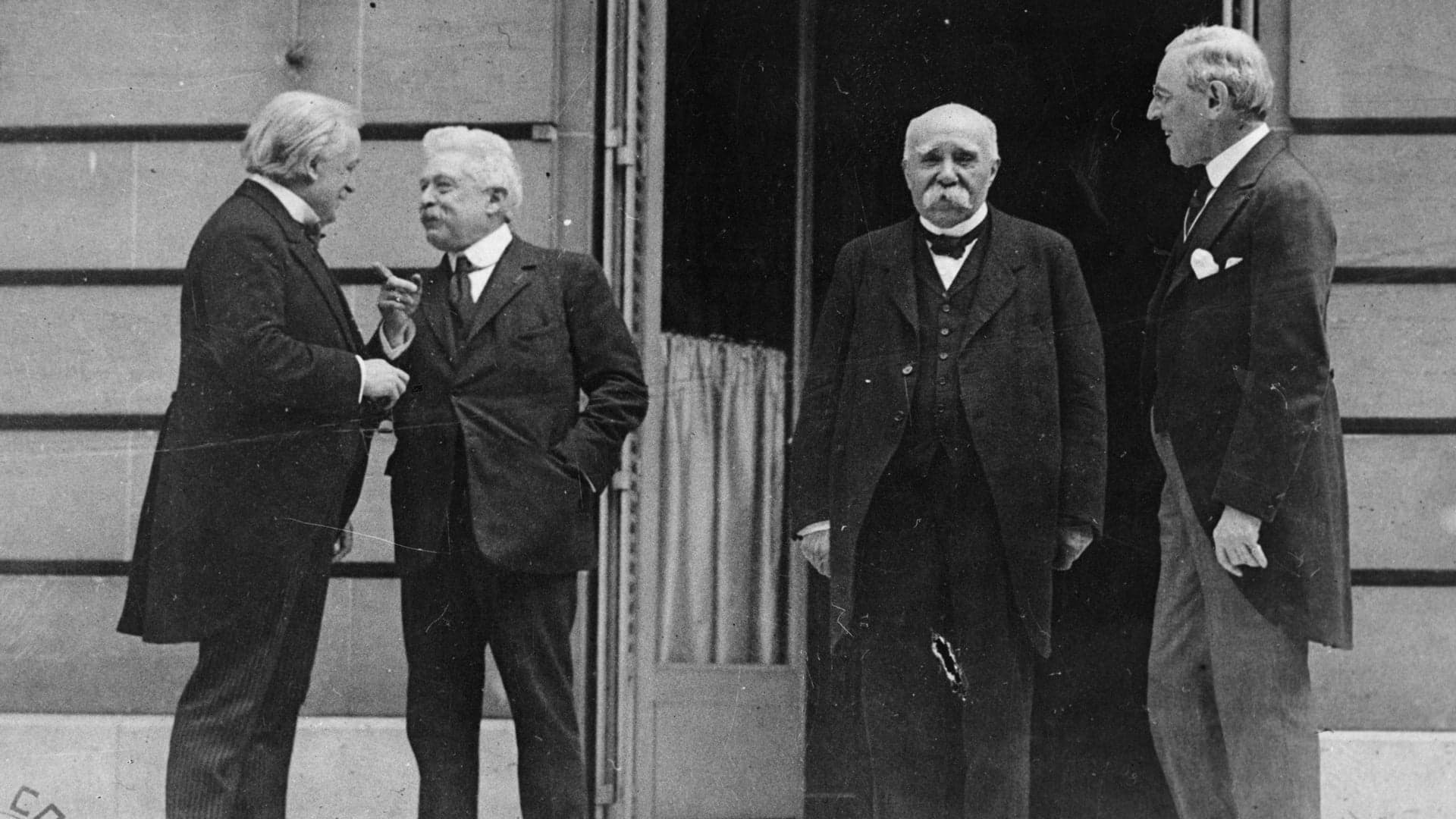
This Day in History Video: What Happened on January 18
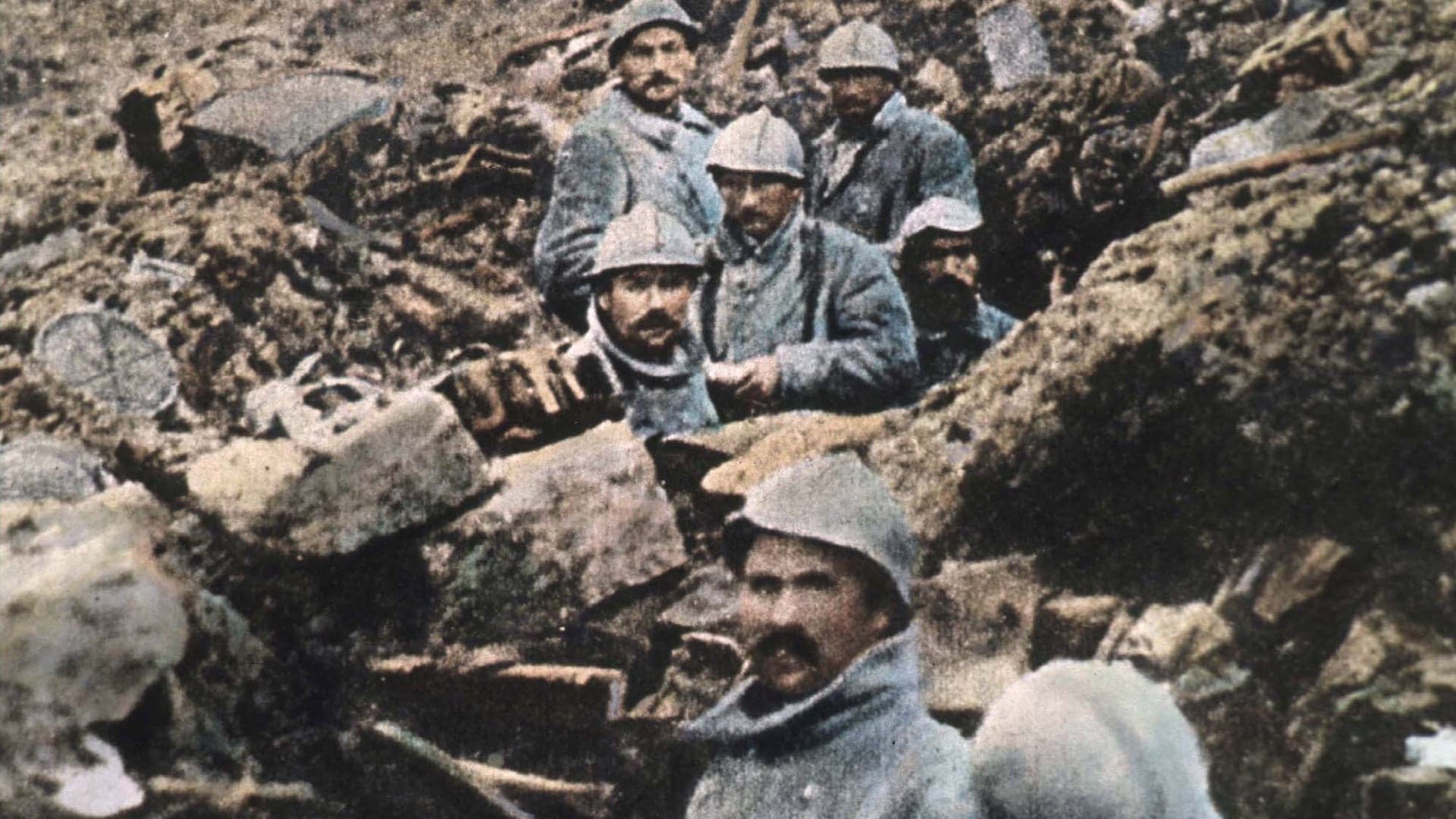
This Day in History Video: What Happened on December 25
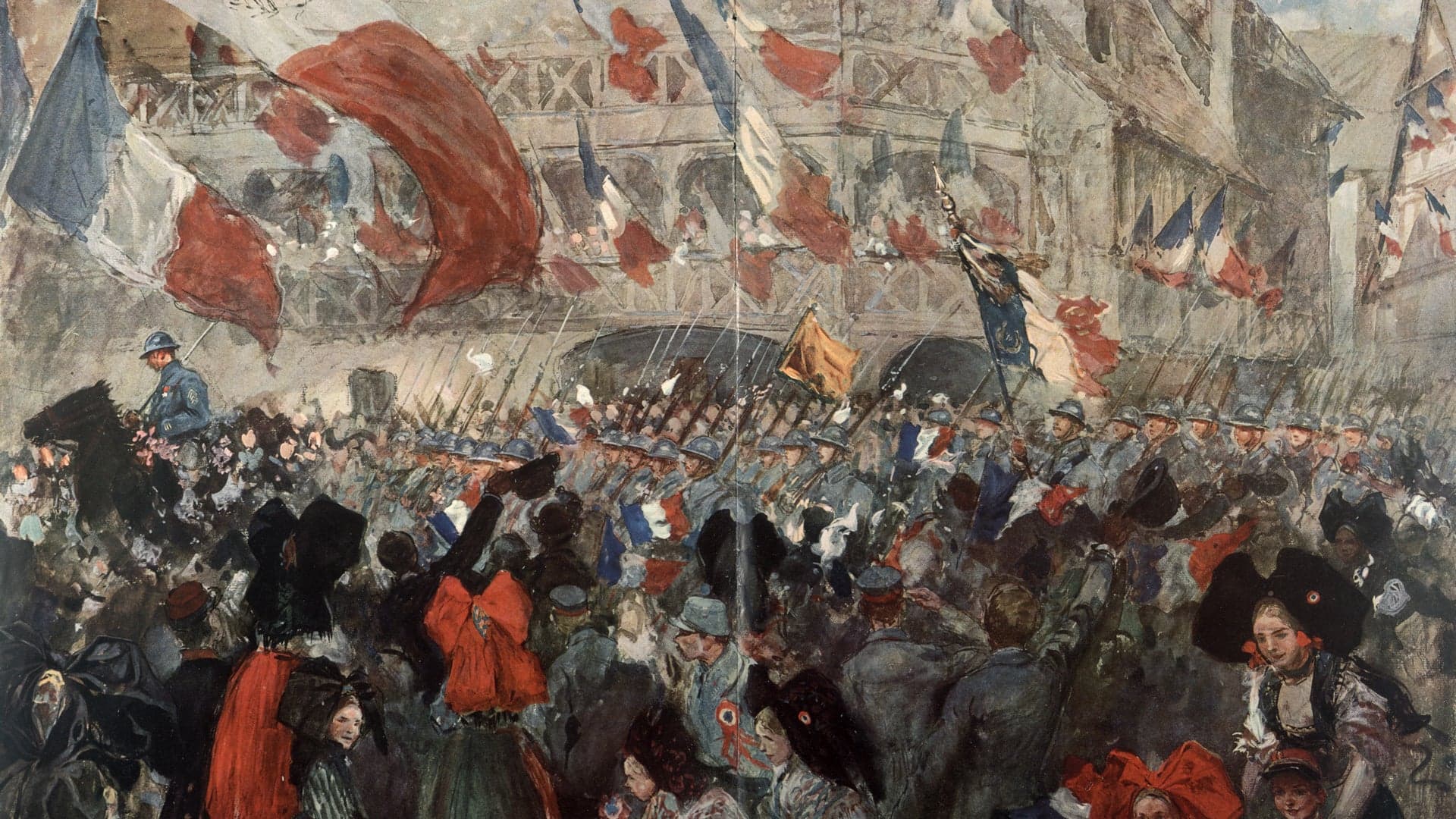
This Day in History Video: What Happened on November 11
Battle of the somme begins, john maynard keynes predicts economic chaos.
Articles on World War I
Displaying 1 - 20 of 324 articles.
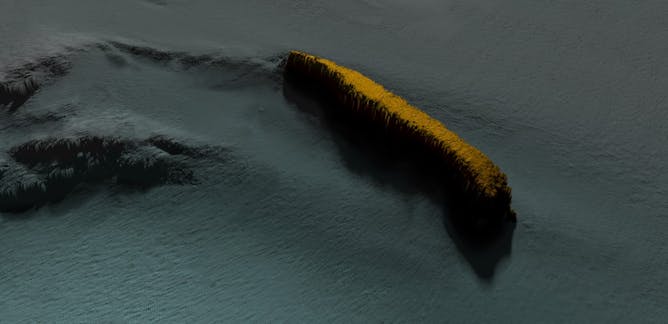
How we discovered the wreck of a torpedoed British ship after a 109-year mystery
Michael Roberts , Bangor University
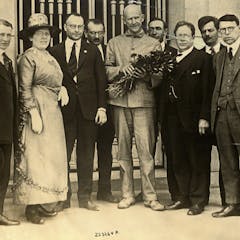
Trump wouldn’t be the first presidential candidate to campaign from a prison cell
Thomas Doherty , Brandeis University
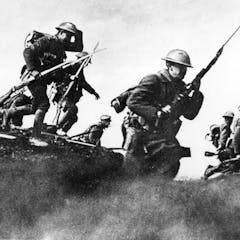
How lessons from the First World War could help Ukraine in the war
John Long Burnham , University of Alberta

Hedd Wyn: how the life of one of Wales’ most promising poets was cut short by the first world war
Alan Llwyd , Swansea University
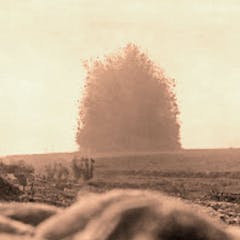
Battle of the Somme: new research shows detonating a massive mine under German lines too early led to a British slaughter
Jamie Pringle , Keele University ; John Paul Cassella , Atlantic Technological University ; Kristopher Wisniewski , Keele University , and Peter Doyle , Goldsmiths, University of London
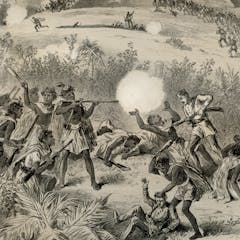
How do we commemorate the New Zealand Wars? The history of Anzac Day can be a guide
Rowan Light , University of Auckland, Waipapa Taumata Rau

Palestine march: some opponents are politicising the Cenotaph to sow divisions – and it could work
Sam Edwards , Loughborough University

The importance of shining a light on hidden toxic histories
Elizabeth Kryder-Reid , Indiana University
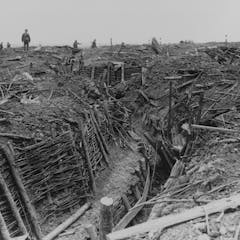

Less than illustrious: remembering the Anzacs means also not forgetting some committed war crimes
Jeffrey McNeill , Massey University

Africans in World War 1: artist William Kentridge’s epic theatre production restores forgotten histories
Fiona Ramsay , University of the Witwatersrand

Pip Williams shows how World War I transformed women’s lives, in a new novel that captures the ‘poetic materiality’ of books
Jen Webb , University of Canberra

Ukraine war: ‘false flag’ operations – long used as weapons of mass distraction under the rules of conflict
David Turns , Cranfield University

Quilts from the Second World War tell the stories of the Canadian women who sewed them
Irene Gammel , Toronto Metropolitan University and Joanna Dermenjian , Toronto Metropolitan University

Time is arrested in Gail Jones’ beautiful new novel of war and art, Salonika Burning
Tanya Dalziell , The University of Western Australia
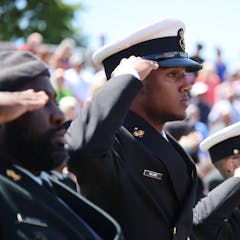
Remembrance Day: Trudeau’s apology to Black servicemen needs to be followed with action
Hyacinth Simpson , Toronto Metropolitan University
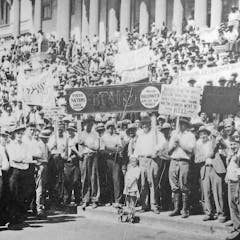
Remembering the veterans who marched on DC to demand bonuses during the Depression, only to be violently driven out by active-duty soldiers
Shannon Bow O'Brien , The University of Texas at Austin College of Liberal Arts

Russia has mobilized for war many times before – sometimes it unified the nation, other times it ended in disaster
Eric Lohr , American University
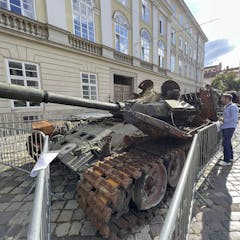
How Ukraine is adapting the ancient practice of trophy displays for modern propaganda
Anya Free , University of California, Davis
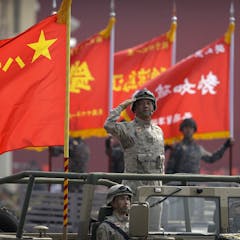
Friday essay: if growing US-China rivalry leads to ‘the worst war ever’, what should Australia do?
Hugh White , Australian National University
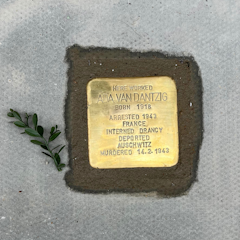
Stolpersteine: UK joins the world’s largest Holocaust memorial
Tim Cole , University of Bristol
Related Topics
- Anzac Centenary
- Australian history
- Military history
- Remembrance Day
- World War II
Top contributors
Professor, University of Leeds
Principal Lecturer in History, Manchester Metropolitan University
Senior Lecturer, School of Humanities and Social Sciences, Deakin University
Chancellor's Professor of Medicine, Liberal Arts, and Philanthropy, Indiana University
Professor of Economics, University of Warwick
Senior Lecturer, History, Australian National University
Associate Professor in Politics and International Relations, Monash University
Assistant Professor, Design History and Theory, Vrije Universiteit Amsterdam
Director, Australian National Dictionary Centre, Australian National University
Research Professor in the Australian Centre for the Study of Armed Conflict and Society, UNSW Sydney
Professor of Creative Arts, Griffith University
Professor of Twentieth Century History, Goldsmiths, University of London
Professor in Media and Communication, Goldsmiths, University of London
Senior Lecturer in English, The Open University
Reader in Modern History, Brunel University London
- X (Twitter)
- Unfollow topic Follow topic

World History I - World War I: Creating a Research Question
- Imperialism and Causes of WW1
- Outcomes of WW1
- Creating a Research Question
- Search Strategies
- Evaluating Sources
- Primary Sources
- MLA Citations
Presentation
"If I had an hour to solve a problem and my life depended on it, I would use the first 55 minutes determining the proper questions to ask. For once I know the proper question, I could solve the problem in less than 5 minutes.
-Albert Einstein
- Click for database USERNAMES and PASSWORDS You must be logged into your @aisr.org account to access the above password document.

Research Starters
- Research Paper Topics - enotes
- Possible Research Topics
- 598 Possible Topics
- Ideas for Research Questions
- 50 Ideas to Get Started
Paper Topics
Qualities of a Good Research Question
1. Interesting to YOU!
2. Focused and manageable within the time/word limit
3. Offers something new (NOT descriptive or overdone)
4. Has context to narrow the topic (includes person, place, or time in history)
Strategies for defining a topic
Sometimes it can be overwhelming to come up with a topic and research question on your own. here are some tips to help:.
1. Develop a tentative focus. List what you know and want to know about a particular topic. Look at the questions that are most interesting to you.
2. Find background information on your topic. Read encyclopedias to get a general sense of your topic. As you read, you will learn more about your topic and you may come across a more specific focus you're interested in knowing more about.
3. Read magazine and newspapers. The articles are short and concise and can provide a general idea of key issues or controversies related to your topic.
4. Check out our Points of View Database. It lists a ton of controversial issues and provides reliable background information which might inspire you to learn more.
5. Read your textbooks. What have you learned in other classes that you'd like to know more about?
6. What's happening in your life? Where do you want to go to school? What job are you interested in? Where would you like to travel? Choose a topic that will apply to your life.
Written with material from the University of Illinois Libguides.
Add context to your question
War as a topic is too huge. So add some context to make it more narrow:
-Place/Event
What was the significance of the Battle of the Bulge in the outcome of WWII?
Break it Down
Bloom's taxonomy.
The bottom of this inverted triangle (Remembering) represents the lowest level of critical thinking and the least interesting or challenging research topics. Aim for the top of the pyramid (Creating, Evaluating, and Analyzing). Try to develop a question which requires you to design, defend, compare/contrast, etc....

- << Previous: Outcomes of WW1
- Next: Search Strategies >>
- Last Updated: Aug 13, 2023 2:15 PM
- URL: https://libguides.aisr.org/worldwarone
173 World War 1 Essay Topics & Examples
If you’re looking for interesting World War I topics, you’re in the right place! StudyCorgi has plenty of WW1 topics to write about. Below is an extensive list of ideas for an essay, thesis, or research paper. Besides WWI research topics and questions, you’ll find free WW1 essay examples. Read them to get inspiration for your work.
🔥 7 Hottest WW1 Topics to Write About
🏆 best ww1 essay topics, 💡 simple topics of ww1, 👍 good world war 1 research topics & essay examples, 🎓 most interesting world war 1 research titles, 📌 easy world war 1 essay topics, ❓ ww1 research questions, 💣 ww1 research topics, ⚔️ more world war 1 topics.
- World War II Was a Continuation of World War I
- Aspects of World War I in Harvey Dunn’s “On the Wire”
- Consequences of World War I and World War II
- America After World War I: A Melting Pot or a Salad Bowl
- World War I: History and Causes
- Renaissance Development and Crisis of the World War I
- Pan-Slavism and Nationalism as Causes of World War I
- The Late Ottoman Empire and World War I This paper evaluates the late Ottoman Empire and World War I by analyzing how the Ottoman empire lived before the war, and how people were recruited.
- World War I: Nationalism, Imperialism, Militarism This paper analyzes how nationalism, imperialism, and militarism irrevocably led to World War I, and how the alliance system contributed to the ultimate outbreak of war.
- Modernization in Post World War I Turkey and Iran After World War I, the important and contradictory process of modernization of Middle Eastern countries could be observed. The prominent examples are Iran and Turkey.
- Impacts on Women’s Role After World War I The demographic, economic, social, and political impacts on women included voting rights, access to education, and better jobs, and changing of women’s positions in society.
- World War I as a Total War World War I was a conflict the nations had never seen before. Over thirty countries lost millions of lives between 1914 and 1918, fighting for their ideals and principles.
- Nursing During World War I: The Importance of the Discipline In the USA, the World War I provided an avenue for nursing to discover the importance of professional training and discipline. This war posed a threat to the status of nursing.
- Conscription in Canada During World War I In Canada, Conscription during World War I was a total failure as it left the nation more divided than it was before.
- Nationalism as a Cause of World War I World War I was triggered by numerous causes, and nationalism is one of them. It is mainly perceived as a sense of pride experienced by a nation.
- World War I: Prerequisites and Consequences World War I is an example of how political ideologies and movements can influence the course of history and people’s perception of current events.
- Events and Causes of World War I World War 1 took place between 1914 and 1918. A number of authors and scholars have come up with possible causes of the First World War. It took place between rich countries.
- Causes and Consequences of World War I The WW I is considered one of the most devastating and horrible military conflicts in the history of humanity, which resulted in the creation of the new world order and the collapse of numerous states.
- World War One: Fundamental Reasons The paper examines the fundamental reasons that have led to World War One and make an accent on the reasons that drew the United States of America into the world conflict.
- The Role of Western Power in the Middle East After World War I This paper examines the role of Western influence in the Middle East after World War I and how their presence shaped the region.
- World War I Reflected in Literature and Art The romantic spirit during the early days of World War I eventually transformed into the personal tragedies of numerous people, which has been reflected in the works of poets.
- Globalization After World War I The emergence of the global economy corresponds to the aftermath of World War I, and the battle of governments and markets for control over the field brought unexpected results.
- World War I and Its Impact on the Life of Europe The Great War affected every aspect of life in Europe. It led to a substantial geopolitical reshuffle, the dissolution of several empires, and the emergence of new nation-states.
- American World War I Propaganda The U.S.A. produced the greatest number of propaganda materials in relation to any other single nation participating in the war.
- History of Aviation in World War I and World War II Aviation history has various periods that crafted its unique story. It began before the seventeenth century and is known for several momentous events that led to its development, such as World War I and World War II.
- The United States’ Role in the World War I The U.S. managed to maintain neutrality for an impressive amount of time, yet even the American government had to define its position toward WWI at some point.
- Pan-Slavism in Fueling World War I The role of Pan-Slavism in fueling WWI has often been put in the center of discussions about this historic event.
- How Woodrow Wilson Led the US to Involvement in World War I President Woodrow Wilson combined legalism, moralism, and idealism to argue for the United States’ entry into World War I.
- Events in the Balkans in Bringing About World War I The Balkan Wars began as a result of the unrest in Macedonia, which caused upheaval in Greece, Serbia, and Bulgaria.
- What Was the Most Significant Reason to the Outbreak of World War 1
- Factors That Made the United States Join the Alliances in World War 1
- How Did the Development of Technology Affect World War 1
- What Expectation Did British Soldiers and Civilians Have of Their Government Following WWI
- The American Home Front During World War 1
- Traditions and Encounters: World War 1
- Fertility Shocks and Equilibrium Marriage-Rate Dynamics: Lessons From World War 1 in France
- Analyzing Propaganda During World War 1
- Good Cynicism and Bitterness From World War 1
- What Was Trench Warfare and What Was Its Impact in World War 1
- How Did the Interdependency of the Alliance Systems Help Lead To the Outbreak of WW1
- The Long Term and Short Term Causes of WW1 and How Each Player Became Involved in the Great War
- How Womens Lives Were Affected by World War 1
- How Did Imperialism Cause World War 1
- How the European Alliance Helped Cause World War 1
- The Impact World War 1 Had on Russia
- How Did the Middle East Change as a Result of World War 1
- What Was Life Like in the Trenches During World War 1
- How Did the Outbreak of WWI Contribute to the Genocide of the Armenians
- Why Australians Joined World War 1
- The Major Alliances of World War I World War I became an arena of the bloody confrontation between two major “armed camps” of the era — the Triple Alliance and the Triple Entente.
- How WWI Changed Women’s Role in America The Great War initiated changes in the societal roles of American women. This was contributed by the contributions that they made during the war.
- Keiser’s Abdication During World War I After realizing that Germany would lose World War 1 on November 9, 1918, Keiser Wilhelm 11 was abdicated as the British Emperor and King of Prussia.
- How Germany Was Reborn After the Defeat in World War I There is an ongoing debate in historical scholarship about how quickly Germany managed to become great again after its defeat in World War I.
- World War I vs. World War II Differences The paper states that there is often a discourse among military historians that the First and Second World Wars are one event or two different ones.
- Events That Led to the Outbreak of World War I World War I may be regarded as a pivot point in modern history due to its impact on the world. Some events led to the outbreak of World War I.
- Trench Warfare During World War I Trench warfare during World War I was characterized by the broad use of occupied lines consisting of trenches guaranteeing better protection to troops.
- World War I and Its Psychological Consequences Different psychological consequences that significantly influenced the nations in World War I included post-traumatic stress disorder, hunger, and grief.
- Participation of Different Nationalities in World War I World War I affected many states, and as the conflict progressed, more countries outside of Europe participated in it, which is why this conflict is a “world war.”
- Stance Against Communist Russia After World War I After World War I, US President Woodrow Wilson took significant steps toward establishing a strict regime of non-acceptance of Soviet ideology and political isolation.
- Post-Traumatic Stress Disorder During and After World War I The paper examines the causes and manifestations of PTSD during and after World War I, despite the absence of this term at that time, and how diagnosis and treatment are made.
- Essentials of Chemical Warfare During World War I Below, the primary aspects of the application of chemical weapons will be presented, making an emphasis on the strategic changes it caused.
- How War Trauma Evolved During World War I This paper is an annotated bibliography that aims to find out how war trauma evolved from clinical and scientific perspectives during World War I.
- The Late Ottoman Empire and World War I The study explains how military knowledge was exchanged between the Ottoman Army, Turkish soldiers, and the Germans during World War I.
- World War I: The Brief Analysis The history of the World War I actually is that of an arms race among the most powerful empires of the early 20th century.
- African-American Experience of World War I and the Harlem Renaissance This article aims to look at the African-American experience throughout World War I and the Harlem Renaissance.
- World War I: Battle of Hill 70 Four months after Vimy Ridge, the Battle of Hill 70 was the first major Canadian battle of the summer and Lieutenant-General Arthur Currie first war in his whole career.
- The Development of Modern America After WWI The development of the automobile industry, the popularity of culture, and the first attempts to maintain international peace boosted the U.S. in a significant way.
- World War I and the Treaty of Versailles At the end of World War I, in the aftermath of the Soviet Union revolution and other developments in Russia, the Treaty of Versailles was adopted in 1918.
- How the Spanish Influenza Was Connected to WWI The Spanish influenza overlapped with the war for approximately nine months and persisted afterwards, with the war playing a major role in its spread and severity.
- The First World War as a Catalyst of Geopolitical Change The First World War is the prologue to the most significant geopolitical change. As a result of it, the Ottoman Empire, the Russian Empire, and the German Empire collapsed.
- WWI and Territorial Changes in Europe This paper reviews how the Russian, Ottoman, German, and Austria-Hungary empires collapsed during and after WWI and which regions were created from the downfall.
- Analysis of the World War 1 and Cold War The First World War is among significant wars that have occurred in history because it led to the Cold War characterized by persistent strains and conflicts.
- Results of World War I for Germany Having studied Germany’s after-war commitments, one should conclude that they could have been one of the principal causes of World War II.
- The Progressive Era and World War I The purpose of this paper is to discuss whether the decision to enter the war was a failure or success from the point of view of the Progressive Era values and ideas.
- Post-WWI America in “Soldier’s Home” by Ernest Hemingway The purpose of this paper is to analyze the short story in terms of its plot, characters, setting, and conflict in relation to its overall message and symbolism.
- “Experiences of World War I Soldiers” Lecture by Isherwood This essay discusses the lecture “Experiences of World War I Soldiers” by Ian Isherwood, from his course “Aftermath: The Experience of War and ‘Modern’ Memory.”
- America’s Entry Into World War I The onset of World War I came with repercussions to the United States, which initially planned on avoiding any confrontations.
- Fallouts of World War I World War I brought dramatic changes in all aspects of life. Globally, the political and governmental structure of world countries were changed.
- Causes of World War I Overview The increase of the armaments and military forces by the European countries in the years preceding 1914 was another predecessor of World War I.
- Workers and Immigrants During the World War I and II The consequences of World War I, the restriction of immigration, and the fear of immigrants led to the isolation of the United States during the 1930s.
- Was World War One the Main Cause of the Russian Revolution? This paper will explore the contribution of the First World War to the subsequent revolution that took place in Russia, analyzing whether the war was the main contributing factor.
- The World War I and the October Revolution Russia’s participation in the First World War added to the misery of the people who not only had to suffer the poverty at home but also had to fight and support an unpopular war.
- World War I (WWI) Effects On American Society WWI brought into America new cultural practices, it became a stimulant for trade, and it also brought into the country a unifying spirit which contributed to the economic success.
- World War 1 Influences Analysis No one state can be charged with causing the world war. It was as a result of economic and political rivalry among nations. There was also the issue of nationalism.
- The Chinese in Canada Before World War I Canada before World War One was characterised by the immigration of foreign communities, especially the Chinese, which resulted in suspicion and fear by locals.
- Employment Opportunities for British Women After World War I Due to the need for Great Britain to unite all of its resources to survive the devastating effect of WWI, the social role and the opportunities for employment changed for women.
- World War I: Wilson Woodrow and League of Nations This is an essay that generally talks about some of the events of World War I, there is a discussion about Wilson Woodrow and his fight for the League of Nations.
- World War I and American Neutrality The U.S. Senate rejected the Treaty of Versailles due to provisions established by Woodrow Wilson regarding collective security and the League of Nations.
- World War I and the United States’ Participation American people will always remember the effects of World War I. It claimed millions of lives and caused the destruction of cultural and architectural masterpieces.
- World War I and the Role of the United States in It When considering the factors that led to the eruption of WWI, one must mention nationalism, imperialism, and militarism.
- The History of Reasons for WWI Outbreak and the United States in WWI On April 6th, 1917, the United States of America decided to enter the First World War after maintaining its neutrality for three years since the conflict’s beginning.
- The World Remade: World War I The World War I became one of the most meaningful events that shaped the history of the humanity and preconditioned the development of the global intercourse in a particular way.
- World War I: Causes and the Entry of the US The assassination of Archduke Franz Ferdinand was the immediate cause of World War I. But the events that led to the Great War go further back into the nineteenth century.
- World War I: Causes and the United States’ Role This paper aims to investigate the underlying causes of World War I along with the exploration of the role of the United States in the war.
- World War I: Pan-Slavism in German-Speaking States This paper analyzes the role of nationalism, imperialism, and militarism and especially the rise of Pan-Slavism in Eastern Europe in German-speaking states.
- World War I and the US’ Role During and After It This paper is dedicated to revealing the causes of World War I as well as defining the role of the United States during the war and after its end.
- World War I and American Participation This paper analyzes the events that drew the United States into World War I. It clearly discusses why America first remained neutral between 1914-1917.
- World War I, Its Chronology and Impacts This paper focuses on World War I that was identified as an important mark in the world’s history. It provides a detailed description of the war and explain its impacts.
- WWI and Interwar Military Innovations WWI triggered the development of an array of interwar military innovations. Today specialization is common in contemporary military forces.
- The League of Nations’ Activity After World War I It should be noted that President Roosevelt, although concerned about Germany’s actions, only gave one speech in Chicago, but no action had followed.
- The United States’ Involvement into World War I Historians agree that numerous forces played a role towards initiating this war. This essay gives a detailed analysis of the major causes of the war and its aftermath.
- World War I: Franz Ferdinand’s Death and Alliances The Great War caused the death of at least 8.5 million soldiers and 7 million civilians. The Great War maimed and injured 20 million people.
- World War I: Nationalism and the US Impact In the case of WWI, nationalism led to the development of a competitive worldwide environment where each country felt the urge to overpower its closest rivals.
- Outbreak of World War I The World War I was inevitable as it resulted from the existing differences, leaders` personal ambitions, and the unstable international situation.
- World War I Aftermath for the United States World War I is one of the darkest moments in modern times. It erupted in 1914 with the world’s powerful nations forming opposing alliances.
- World War I and Political World Domination The complexity of the origins of World War I is undeniable, but it is possible to observe that one of the crucial factors was the struggle for domination on the political map.
- World War I Provocative Phenomenas The World War I demonstrated the role of the alliance system, the use of poison gas, and the effect of the genocide on the nations’ development.
- The Reaction of the American Citizens to the US Entry into World War I World War I left a lasting impact on America, influencing the next ten years of American foreign policy and domestic policy.
- Recruitment, Censorship and Propoganda in WW1 in Both Britain and Germany
- Discovering the American Past in World War 1
- Which Was the More Important Cause of World War 1
- The Most Influential Underlying Causes of World War 1
- Canadian History Since World War 1
- Comparison Between World War 1 And World War 2
- Military Leaders World War 1 as Well as After the War
- The Differences Between WWI and WWII
- The Bauhaus Movement During the World War 1
- What Expectation Did British Soldiers and Civilians Have of Their Government Following WWI?
- Causes Effects and Aftermath of World War 1 History
- How America Suffered From World War 1
- Aircraft During World War 1 and World War 2
- Liberal Democracy and Capitalism After World War 1
- Germany Between World War One to World War Two: Culture and Politics
- The Four Main Long-Term Causes of World War 1
- Industrial Revolution and the World War 1
- How Did the Location of Industry Respond to Falling Transport Costs in Britain Before World War 1
- The Fallout After World War 1 and the Great Depression
- The United States’ Entry Into World War 1
- How Did WW1 Lead to the Development of the Medical Field of Plastic Surgery?
- What Did the Intelligence Tradecraft Develop During World War 1?
- Did Britain Want Germany Weak After World War 1?
- Why Did Italy Enter Into World War 1?
- How Did Technological Developments During WW1 Affect the Soldiers Who Fought?
- Was WW1 the Result of Tensions Caused by German Nationalism?
- Should the United States Have Entered World War 1?
- Why Was World War 1 a Total War for Britain?
- What Was the Political Impact of World War 1?
- How Did Modern Weapons Change Combat in the First World War?
- Did WW1 Change the Status of Women?
- Was Germany Responsible for the Outbreak of World War 1?
- What Was the Underlying Cause of World War 1?
- How Did the World War 1 Change British Society?
- Why Did Australia Become Involved in World War 1?
- Should Any One Nation Be Seen as Responsible for the Outbreak of the First World War?
- How Did the First World War Affect Britain?
- What Was the Contribution of Britain to the Defeat of Germany in WW1?
- Did the First World War Liberate British Women?
- Why Did Central Power Lose the World War 1?
- How Did World War 1 Exacerbate Europe’s Economic Problems?
- Was the United States Genuinely Neutral During the First Years of World War 1?
- Did the First World War Represent an Irrevocable Crisis of Gender in the UK?
- How Did World War 1 Influence Modern-Day Art?
- Why Did Aircraft Make Significant Differences in World War 1?
- The role of nationalism in fueling WWI.
- Conditions, strategies, and impact of trench warfare during WWI.
- The significance of new weapons and military technology in WWI.
- The role of propaganda in shaping public opinion during WWI.
- The effects of WW1 on the lives of civilians.
- Immediate and long-term consequences of the Treaty of Versailles.
- The significance of colonial troops in WWI.
- Artistic responses to WWI and its aftermath.
- The impact of WWI on the global balance of powers.
- The progress in medical practices and treatments during WWI.
- Diplomatic failures and tensions that led to WWI.
- The experiences of soldiers in the trenches.
- Women’s non-combat roles during WW1.
- The role of espionage and intelligence in WW1.
- Religious institutions’ responses to WWI.
- The involvement of non-European countries in WW1.
- Aerial warfare strategies in WWI.
- The role of war correspondents in reporting on WW1.
- The impact of WW1 on subsequent conflicts and international relations.
- Ways in which WWI is remembered and commemorated in different countries.
Cite this post
- Chicago (N-B)
- Chicago (A-D)
StudyCorgi. (2021, September 9). 173 World War 1 Essay Topics & Examples. https://studycorgi.com/ideas/world-war-1-essay-topics/
"173 World War 1 Essay Topics & Examples." StudyCorgi , 9 Sept. 2021, studycorgi.com/ideas/world-war-1-essay-topics/.
StudyCorgi . (2021) '173 World War 1 Essay Topics & Examples'. 9 September.
1. StudyCorgi . "173 World War 1 Essay Topics & Examples." September 9, 2021. https://studycorgi.com/ideas/world-war-1-essay-topics/.
Bibliography
StudyCorgi . "173 World War 1 Essay Topics & Examples." September 9, 2021. https://studycorgi.com/ideas/world-war-1-essay-topics/.
StudyCorgi . 2021. "173 World War 1 Essay Topics & Examples." September 9, 2021. https://studycorgi.com/ideas/world-war-1-essay-topics/.
These essay examples and topics on World War 1 were carefully selected by the StudyCorgi editorial team. They meet our highest standards in terms of grammar, punctuation, style, and fact accuracy. Please ensure you properly reference the materials if you’re using them to write your assignment.
This essay topic collection was updated on January 20, 2024 .
Lemieux Library and McGoldrick Learning Commons
Catalog search, site search.
- Seattle University
- Lemieux Library
Primary Sources for Research
- World War I
- Defining Primary and Secondary Sources
- Distinguishing Primary & Secondary Sources
- Key Sources
- Library Catalog-Primary Sources-Microforms
- United States
- Media : Video, Audio
- Historical Newspapers
- Africa, Near East, Middle East
- Central, Latin, So America
- Pacific Northwest
- Women's Rights, Human Rights
- Seattle U Special Collections
- Evaluating Sources
- Annotated Bibliography
- Oral Histories
Get Research Help
Mary linden sepulveda.

Key Primary Sources: Subscription Databases
- The First World War This link opens in a new window A sub-collection of AM Explorer, this portal showcases First World War primary sources. From personal collections and rare printed material to military files, artwork and audio-visual files, content highlights the experiences of soldiers, civilians and governments on both sides of a the war.
- Empire Online This link opens in a new window A sub-collection of AM Explorer, this collection of primary sources includes manuscript and rare printed sources documenting cultural contacts, literature of empire, the visible empire and imperial aspects of race, class and religion from 1492-1962.
- Everyday Life and Women in America, c1800 1920 This link opens in a new window A sub-collection of AM Explorer, this primary source collection includes material for the study of American social, cultural, and popular history in the 19th and early 20th centuries
Primary Sources : More Digital Collections
- AM Explorer This link opens in a new window Access millions of pages of primary source collections across the entire portfolio of Adam Matthew Digital, spanning content from the 15th-21st centuries.
- EURODOCS One of the best places to start for all time periods of European history. Extensive collection of primary sources and links to other sites. Browse by broad era (prehistory/ancient, medieval/renaissance, modern) or by country.
- Europeana 1914-1918 – untold stories & official histories of WW1 This link is part of the EuroDocs digital archive collection that brings together personal items contributed by the public, national library collections, and film archives to offer a unique perspective of the First World War, showing it from every side of the battle lines and with insights from every point of view.
- First World War.com A collection of primary documents that mark the course of the war. Included are archive documents signed in the late 1830s which bore relevance to the outbreak of war some 75 years later, as well as memos, letters, treaties and the text of speeches throughout the war and beyond.
- Imperial War Museum: First World War Galleries Website of IWM London provides selected photographs and newsreels of World War 1.
- League of Nations: Statistical and Disarmament Documents This collection contains the full text of 260 League of Nations document, with a focus on three areas: the founding of the League, international statistics published by the League, and the League's work toward international disarmament.
- National Archives (U.K.) List of online exhibitions; browse by name or historical period. Includes selections dating from 1066 through the 20th century.
- Propaganda Postcards of the Great War This Library of Congress collection features a collection of war-themed postal cards produced during World War 1 (1914-1919).
- The Stars and Stripes: The American Soldiers' Newspaper of World War I The newspaper's mission was to provide scattered troops with a sense of unity and an understanding of their part in the overall war effort. Part of the Library of Congress Digital Collections the date coverage is February 8, 1918, to June 13, 1919.
- War Posters and Postcards Posters from government, commercial and charitable organizations. Subject matter is diverse, covering such topics as military recruitment, rationing, films/theatre, anti-war movements and many others.
- Western European Theater Political Pamphlet Collection Pamphlets collected by the Princeton University Library starting from the outbreak of World War I. There is limited access through the finding aids for digital images in this pamphlet collection published in Europe during and immediately after World War I. They cover a broad range of topics including the economy, the press, the military, arms, territorial disputes, and others. The collection also includes speeches, sermons, bulletins, calendars, and songbooks. Covers 1894-1918.
- Women Working, 1800-1930 Access to digitized books, manuscripts and images from the collections of Harvard University Libraries and Museums on women in the U.S. economy from 1870-1930. Searchable, or browsable by topic, individual, dates and events, or organization.
- World War History: Newspaper Clippings, 1914 to 1926 Newspaper clippings from the 400-volume, World War History: Daily Records and Comments as Appeared in American and Foreign Newspapers, 1914-1926. "The clippings yield significant information about the political, social, cultural, and economic impact of the war as it is taking place and its aftermath....and contain war-related editorials, features, cartoons, photos, maps, and more." [Library of Congress Digital Collections]
- World War I Collection "Provides a sampling of UW-Madison's World War I Special Collection...Most of these materials were acquired by the University during or in the immediate aftermath of the war and they represent a direct and often very passionate or partisan viewpoint of that conflict." [limited access]
- World War I Documentary Archive Contains full text, images, biographies, personal reminiscences and links to other web resources.
- World War I Postcards from the Bowman Gray Collection Features a collection of war-themed cards produced in Great Britain, France, Italy, Germany, Russia, and the U.S. during World War One (1914-1918).
- World War I in Photos: Global Conflict [The Atlantic] Photos from Part 8 of a 10 part series on WWI. [Alan Taylor; The Atlantic; April 27,2014 issue]
- World War I in Photos [The Atlantic] Link to the 10 part series of World War I photos by Alan Taylor. [The Atlantic; April 2014]
Selected citations by permission of UCSanDiego; Kelly L. Smith https://ucsd.libguides.com/primarysources/home
Video & Films
- British Pathe War Archives: Historical film vignettes on the impact of The Great War/World War One, including stories of animals,battles,psychological scars of warfare and more.Free limited trials; or access through uTube
- Testament of Youth [streaming video] Testament of Youth is a powerful story of love, war and remembrance, based on the First World War memoir by Vera Brittain, which has become the classic testimony of that war from a woman's point of view.
Secondary Sources : E-books
Historic Microfilm in the Seattle U Library Collection
- The First World War, a documentary record. Series one, European War, 1914-1919, the War Reserve Collection (WRA-WRE) from Cambridge University Library [microform]. Call Number: D505 .F57 1991 5th fl 114 microfilm reels 2nd Floor-Reference Books D505 .F57 1991 pt.3-4 Guide
- << Previous: By Topics
- Next: Women >>
- Last Updated: Jan 16, 2024 1:17 PM
- URL: https://library.seattleu.edu/guides/primary-sources
- Student Opportunities
About Hoover
Located on the campus of Stanford University and in Washington, DC, the Hoover Institution is the nation’s preeminent research center dedicated to generating policy ideas that promote economic prosperity, national security, and democratic governance.
- The Hoover Story
- Hoover Timeline & History
- Mission Statement
- Vision of the Institution Today
- Key Focus Areas
- About our Fellows
- Research Programs
- Annual Reports
- Hoover in DC
- Fellowship Opportunities
- Visit Hoover
- David and Joan Traitel Building & Rental Information
- Newsletter Subscriptions
- Connect With Us
Hoover scholars form the Institution’s core and create breakthrough ideas aligned with our mission and ideals. What sets Hoover apart from all other policy organizations is its status as a center of scholarly excellence, its locus as a forum of scholarly discussion of public policy, and its ability to bring the conclusions of this scholarship to a public audience.
- Scott Atlas
- Thomas Sargent
- Stephen Kotkin
- Michael McConnell
- Morris P. Fiorina
- John F. Cogan
- China's Global Sharp Power Project
- Economic Policy Group
- History Working Group
- Hoover Education Success Initiative
- National Security Task Force
- National Security, Technology & Law Working Group
- Middle East and the Islamic World Working Group
- Military History/Contemporary Conflict Working Group
- Renewing Indigenous Economies Project
- State & Local Governance
- Strengthening US-India Relations
- Technology, Economics, and Governance Working Group
- Taiwan in the Indo-Pacific Region
Books by Hoover Fellows

Economics Working Papers

Hoover Education Success Initiative | The Papers

- Hoover Fellows Program
- National Fellows Program
- Student Fellowship Program
- Veteran Fellowship Program
- Congressional Fellowship Program
- Media Fellowship Program
- Silas Palmer Fellowship
- Economic Fellowship Program
Throughout our over one-hundred-year history, our work has directly led to policies that have produced greater freedom, democracy, and opportunity in the United States and the world.
- Determining America’s Role in the World
- Answering Challenges to Advanced Economies
- Empowering State and Local Governance
- Revitalizing History
- Confronting and Competing with China
- Revitalizing American Institutions
- Reforming K-12 Education
- Understanding Public Opinion
- Understanding the Effects of Technology on Economics and Governance
- Energy & Environment
- Health Care
- Immigration
- International Affairs
- Key Countries / Regions
- Law & Policy
- Politics & Public Opinion
- Science & Technology
- Security & Defense
- State & Local
- Books by Fellows
- Published Works by Fellows
- Working Papers
- Congressional Testimony
- Hoover Press
- PERIODICALS
- The Caravan
- China's Global Sharp Power
- Economic Policy
- History Lab
- Hoover Education
- Global Policy & Strategy
- National Security, Technology & Law
- Middle East and the Islamic World
- Military History & Contemporary Conflict
- Renewing Indigenous Economies
- State and Local Governance
- Technology, Economics, and Governance
Hoover scholars offer analysis of current policy challenges and provide solutions on how America can advance freedom, peace, and prosperity.
- China Global Sharp Power Weekly Alert
- Email newsletters
- Hoover Daily Report
- Subscription to Email Alerts
- Periodicals
- California on Your Mind
- Defining Ideas
- Hoover Digest
- Video Series
- Uncommon Knowledge
- Battlegrounds
- GoodFellows
- Hoover Events
- Capital Conversations
- Hoover Book Club
- AUDIO PODCASTS
- Matters of Policy & Politics
- Economics, Applied
- Free Speech Unmuted
- Secrets of Statecraft
- Pacific Century
- Libertarian
- Library & Archives
Support Hoover
Learn more about joining the community of supporters and scholars working together to advance Hoover’s mission and values.
What is MyHoover?
MyHoover delivers a personalized experience at Hoover.org . In a few easy steps, create an account and receive the most recent analysis from Hoover fellows tailored to your specific policy interests.
Watch this video for an overview of MyHoover.
Log In to MyHoover
Forgot Password
Don't have an account? Sign up
Have questions? Contact us
- Support the Mission of the Hoover Institution
- Subscribe to the Hoover Daily Report
- Follow Hoover on Social Media
Make a Gift
Your gift helps advance ideas that promote a free society.
- About Hoover Institution
- Meet Our Fellows
- Focus Areas
- Research Teams
- Library & Archives
Library & archives
Events, news & press.

The Relevance Of World War I
In the decades before the First World War, vast scientific and technological changes altered the face of the globe. Those changes had immense implications for the world’s military institutions. The invention of the internal combustion engine, nitroglycerine, smokeless power, barbed wire, the telephone, and medical advances had all changed the civilian world and seemed to have major implication for the conduct of war. They did. Most military experts calculated that such technological changes would lead to quicker wars. In that respect, they were wrong.
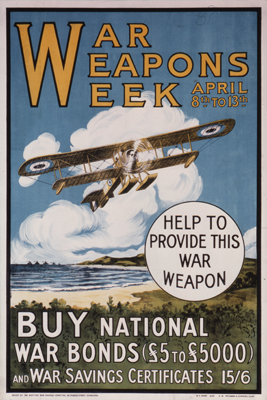
In the decades before the First World War, vast scientific and technological changes altered the face of the globe. Those changes had immense implications for the world’s military institutions. The invention of the internal combustion engine, nitroglycerine, smokeless power, barbed wire, the telephone, and medical advances had all changed the civilian world and seemed to have major implication for the conduct of war. They did. Most military experts calculated that such technological changes would lead to quicker wars. In that respect, they were wrong. In fact, the massive industrial and societal changes confronted Europe’s military organizations with a whole host of unintended consequences. While the technological changes had certainly made the battlefield more lethal, they also enabled the combatants to suffer immense manpower and resource losses and still remain on the battlefield. It took nearly four years before the armies on the Western Front were capable of breaking through the dense and increasingly effective defenses their opponents had established.
What does this have to do with the problems we confront today? As with the period before the First World War, technological change is being driven by the civilian world outside of the military sphere. Moreover, the technological changes appear to be occurring at an increasing rate. The implications for the military, then, are considerable. Adaptation to these changes demands the imagination to understand not only how they might increase our own capabilities, but how a potential opponent might use such changes to greatest effect against our weaknesses. In a period of declining defense budgets, what new technological capabilities to buy raises substantial questions. The character of war—the context of ever changing weapons and tactics—is such that the ability to innovate in peacetime and adapt to the actual conditions of war are the most important qualities that senior leaders and their staffs must possess. Cyber warfare, drones, EMP (electromagnetic pulse) weapons, biological capabilities, all influenced by the explosion of computing power, represent threats and possibilities that are incalculable until they appear on the battlefield.
The problem though is that at present the American military is spending more time in addressing the issues raised by political correctness instead of dealing with the harsh realities of a world where our opponents seem to be closing the asymmetric gap between America’s combat capabilities and their own. Too much of the time finds senior leadership demanding that those training their units focus on politically correct issues instead of preparing their troops for the nasty business of war.
The failure of Europe’s political and military leaders in 1914 to understand the import of the scientific and technological changes that their world was undergoing resulted in catastrophic destruction and lives lost. But perhaps the greatest casualty was the sense of security that the collapse of the world caused. The warning is there: we can prepare now by more thorough and perceptive thinking, or we can learn on the battlefield by filling body bags.
View the discussion thread.

Join the Hoover Institution’s community of supporters in ideas advancing freedom.

World War I - The Great War
- Periodicals
- Internet Resources
- Primary Sources
- Archives & Special Collections
- K-12 Education Resources
Database Instructions
You can find the Databases' sub-tab on the Library's Home Page. All of these databases are available for on and off-campus users at http://www.library.ncat.edu .
To find databases from the Library Home Page:
- Choose the Databases tab from the Library home page
- Click View Databases by Title
- Look in alphabetical order for the name of the database

Please note : For off-campus access use your username and password that you use for wifi and Blackboard.
Library of Congress Subject Headings
- First World War
- The Great War
- World War 1
- World War I
- World War One
Other Possible Keywords/Subject Headings
The War to End All Wars
The War of the Nations
African Americans and World War I
Women and World War I
Casualties and World War I
Enlisted Personnel and World War I
Regiments, Units, Formations, and Battalions in World War I
Europe and World War I
Medicine and World War I
The Homefront during World War I
Battles and World War I
Airpower and World War I
Seapower and World War I
Weaponry and World War I
External Databases
- International Encyclopedia of the First World War
- Online World War I Indexes and Records - USA
- World War I Biographical Dictionary
- Europeana WWI Collections 1914-1918
- Military Resources World War I - National Archives
- World War I Document Archive
- Newspaper Pictorials: World War I Rotogravures, 1914 to 1919
- World War History: Newspaper Clippings, 1914 to 1926
- HathiTrust Digital Library
- Digital Public Library of America
- Academic Search Ultimate This link opens in a new window Academic Search Ultimate provides access to full-text articles from a wide variety of disciplines.
- Military and Government Collection This link opens in a new window Military & Government Collection offers current news pertaining to all branches of the military and government, including full text for nearly 300 journals and periodicals. The database also offers indexing and abstracts for more than 400 journals.
- ProQuest Military This link opens in a new window The Military Database covers topics across all government and military branches, including international relations, political science, criminology, defense, aeronautics and space flight, communications, civil engineering, and more. An important benefit of the Military Database is its content diversity. Included are scholarly journals, trade and industry journals, magazines, technical reports, conference proceedings, government publications, and more.
- Project Muse This link opens in a new window Currently, Project MUSE Premium Collection offers 300 humanities, arts, and social sciences journals from 60 scholarly publishers. Project MUSE covers the fields of literature and criticism, history, the visual and performing arts, cultural studies, education, political science, gender studies, economics, and many others.
- African American Biographical Database This link opens in a new window African American Biographical Database is the largest electronic collection of biographical information on African Americans from 1790-1950. Biographies of thousands of African Americans, many not found in other reference sources, are assembled from biographical dictionaries and other sources. Includes extended narratives of African American activists, former slaves, performing artists, educators, writers, and more.
- JSTOR This link opens in a new window The JSTOR project seeks to develop online access to the full back files of selected journals. The database contains a digitized image of every page and is searchable by every word.
- PubMed This link opens in a new window PubMed is a database with access to articles in biomedical and life science journals, many of which are full-text.
- ProQuest East Europe, Central Europe Database This link opens in a new window This database provides ongoing full-text academic journals that are locally published by scholarly publishing organizations and educational institutions in East European and Central European countries. Major subject areas of study are represented, including business, science, technology, engineering, social sciences, education, and humanities.
- << Previous: Books
- Next: Periodicals >>
- Last Updated: Oct 2, 2023 1:12 PM
- URL: https://libguides.library.ncat.edu/wwi
Resources for Genealogists

Researching Individuals in WW1 Records
Start your research.
You may first want to search the WW1 Draft registration cards for basic information on individuals (see Draft cards section below). Nearly all men between the ages of 18-45 registered during the years the draft was implemented, about 23% of the U.S. population.
If you are interested in researching military service records, this article will provide you with a good overview of military records at the National Archives .
What do I need to know before I start?
What records can I see online?
Where at the National Archives can I find the records?
What records can I find in other archives and organizations?
What other resources will help me find information?
African Americans - WW1
Records of Military Agencies Relating to African Americans from the Post-World War I Period to the Korean War , Reference Information Paper
Blacks in the Military , resources compiled by NARA's Archives Library Information Center (ALIC)
Deaths - WW1
World War I Dead Buried in American Battle Monument Commission Cemeteries, Missing in Action, or Buried or Lost at Sea
World War I Gold Star Mothers Pilgrimages , an article in Prologue magazine
Draft Registration Cards - WWI
The WWI draft registration cards consist of approximately 24,000,000 cards of men who registered for the draft, about 23% of the population in 1918. The cards are arranged by state. Not all of the men who registered for the draft actually served in the military, and not all who served in the military registered for the draft.
The WWI Selective Service System was in place from May, 1917 to May, 1919. There were 3 registrations:
- June 5, 1917 -- all men ages 21-31
- June 5, 1918 -- those who attained age 21 after June 5, 1917
- Sept. 12, 1918 -- all men ages 18-45
What Can You Find in the Cards?
While the 10-12 questions varied slightly between the 3 registrations, information one can find there generally includes:
- date and place of birth
- citizenship status
- occupation and place of employment
- personal description
- nearest relative (last two versions)
The draft cards contain no information about an individual's military service. They are not service cards. Learn more about the draft registration cards
View Registration Cards Online
World War I Draft Registration Cards , digitized on the FamilySearch website (free)
World War I Selective Service System Draft Registration Cards, 1917-1918 , digitized on the Ancestry.com website (free on NARA computers, otherwise by subscription)
Additional Resources
International Researchers "Jazzed" about Southeast Region's WWI Draft Registration Cards , NARA news item
Selected World War I Draft Registration Cards of the Famous, Infamous, and Interesting , from the National Archives at Atlanta
Military Service Records - WW1
- Records Relating to the Meuse-Argonne Offensive
- List of Series Relating to World War I at the National Archives at St. Louis
- They Answered the Call, Military Service in the United States Army During World War I, 1917-1919 , an article in Prologue magazine, Fall 1998
- An Overview of Records at the National Archives Relating to Military Service
- Where to Find Military Service and Pension Records at NARA
- Military Reference Reports
- General Index to Pension Files, 1861-1934 (See also descriptive pamphlet for Microfilm T-288 )
- 20th-Century Veterans' Service Records Safe, Secure-and Available , an article in Prologue Magazine about the National Personnel Records Center
How to Order Records
Ordering information for military service records
Veterans' Homes
- Leavenworth Soldiers Home, Leavenworth, Kansas, ca. 1885 - ca. 1933 , Sample Case Files of Veterans Temporarily at the Branch
- Leavenworth Soldiers Home, Leavenworth, Kansas, ca. 1885 - ca. 1933 , Sample Case Files of Veterans
- Sawtelle Disabled Veterans Home Case Files, Los Angeles, 1888-1933
See also our main WW1 topics page
What are people asking on History Hub about Genealogy Records?

- Forum Post: RE: 1900 census Rapides Louisiana
- Forum Post: RE: How can I find 1860 census for Clio Alabama
- Forum Post: RE: I am looking for a searchable copy of the 1860 Federal census for Lincoln County Tennesse
Find answers to your research questions at History Hub
What are people asking on History Hub about World War I records?
- VA Claims File Question
- RE: I want to find information about my grand grandfather, who emigrated from Armenia before The second World War, I just want to know about his heritage. His name Mkrtich Nahapetian (his name could be changed). Location Missuri, St. Louis (1930-1950)
- RE: Flying Tigers based in China
- RE: military abbreviation "USVB"
Read our research on: Abortion | Podcasts | Election 2024
Regions & Countries
Majority in u.s. say israel has valid reasons for fighting; fewer say the same about hamas, 57% express some sympathy for both israelis and palestinians.
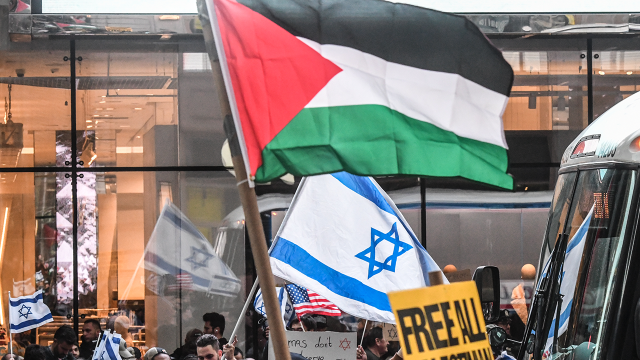
Pew Research Center conducted this survey to explore views about the Israel-Hamas war. We surveyed a total of 12,693 U.S. adults from Feb. 13 to 25, 2024. Most of the respondents (10,642) are members of Pew Research Center’s American Trends Panel, an online survey panel recruited through national random sampling of residential addresses, which gives nearly all U.S. adults a chance of selection.
The remaining 2,051 respondents are members of three other survey panels – Ipsos’ KnowledgePanel, SSRS’s Opinion Panel, and NORC at the University of Chicago’s AmeriSpeak Panel – who were interviewed because they identify as Jewish or Muslim.
We “oversampled” (i.e., interviewed a disproportionately large number of) Jews and Muslims to provide more reliable estimates of their views on the topics covered in this survey. But these groups are not overrepresented in the national estimates reported here, because we adjusted for the oversampling in the weighting of the data. The survey is weighted to be representative of the U.S. adult population by gender, race, ethnicity, partisan affiliation, education, religious affiliation and other categories. In total, 1,941 Jewish and 414 Muslim respondents participated in this survey.
While the sample design was identical for Jews and Muslims, the resulting sample sizes are different. There are two main reasons for this. The Jewish population in the United States is roughly double the size of the Muslim population . Consequently, national survey panels have roughly twice as many or more Jewish panelists as Muslim ones. In addition, decades of research on survey nonresponse has shown that some groups in the U.S. are more likely to participate in surveys than others. Generally speaking, Jewish adults are more likely to participate in surveys than Muslim adults.
The survey also included questions about where people were born and whether people identify as Arab or of Arab origin. Because of insufficient sample size, we are unable to analyze Arab Americans or Americans of Israeli or Palestinian descent separately.
In this survey, Jews and Muslims are defined as U.S. adults who answer a question about their current religion by saying they are Jewish or Muslim, respectively. Unlike our 2020 report on Jews in America , this report does not separately analyze the views of “Jews of no religion” (i.e., people who identify as Jewish culturally, ethnically or by family background but not by religion).
For more information on how we conducted this survey, refer to the ATP’s Methodology and the Methodology for this report. Read the questions used in this report , along with responses.
Months into the Israel-Hamas war, roughly six-in-ten Americans (58%) say Israel’s reasons for fighting Hamas are valid. But how Israel is carrying out its response to Hamas’ Oct. 7 attack receives a more mixed evaluation. About four-in-ten U.S. adults (38%) say Israel’s conduct of the war has been acceptable, and 34% say it has been unacceptable. The remaining 26% are unsure.
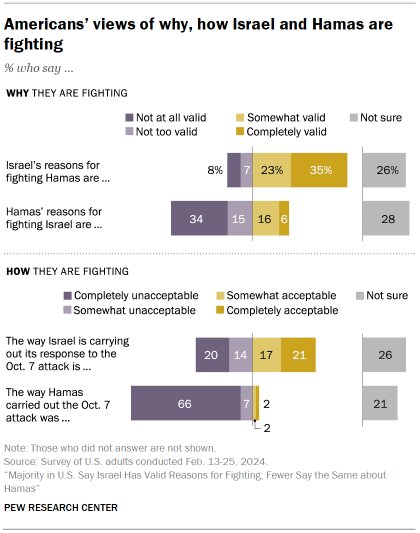
Only around one-in-five Americans (22%) think the way the Israeli government is carrying out the war against Hamas will make the Israeli people more secure than they were before the war. The rest think the war will make Israelis less secure (27%), not have much effect (15%) or say they are unsure (35%).
When asked about Hamas’ reasons for fighting Israel, far fewer Americans (22%) describe them as valid. And just 5% of U.S. adults say the way Hamas carried out its Oct. 7 attack on Israel was acceptable, while 66% describe it as completely unacceptable.
Also, few Americans (10%) think Hamas’ actions will make the creation of an independent Palestinian state more likely than it was before the war. Around a third of the U.S. public thinks it will make an independent state less likely (32%) while 15% say it will not have much effect and 41% are unsure.
Some questions in this survey ask Americans for opinions on how Israel and Hamas have been fighting. Other questions ask for opinions on why each side has been fighting.
After pretesting the questions, here is the exact wording we settled on:
How they are fighting
- Do you think the way Hamas carried out its attack on Israel on Oct. 7 was … Completely acceptable, Somewhat acceptable, Somewhat unacceptable, Completely unacceptable, Not sure
- Do you think the way Israel is carrying out its response to Hamas’ Oct. 7 attack is … Completely acceptable, Somewhat acceptable, Somewhat unacceptable, Completely unacceptable, Not sure
Why they are fighting
- Regardless of how acceptable you find the way Hamas carried out the Oct. 7 attack, do you think Hamas’ reasons for fighting Israel are … Completely valid, Somewhat valid, Not too valid, Not at all valid, Not sure
- Regardless of how acceptable you find the way Israel is carrying out the war in Gaza, do you think Israel’s reasons for fighting Hamas are … Completely valid, Somewhat valid, Not too valid, Not at all valid, Not sure
This issue is challenging for many people – both emotionally and in terms of understanding the specifics of the war. Many Americans are also disengaged: Relatively few (22%) say they are closely following news about the war, and half can correctly report that more Palestinians than Israelis have died since the war’s start. On many questions about the war, sizable numbers express no opinion.
These and other results come from a new Pew Research Center survey, conducted Feb. 13-25, among 12,693 adults. Unlike most polling in the United States since the war began, this survey includes enough Jewish and Muslim respondents to allow their views to be analyzed separately.
When it comes to how Jews and Muslims feel about why and how the two sides are fighting, we find:
Views on why they are fighting
- Regardless of whether they approve of how Israel is fighting the war, most U.S. Jews (89%) see Israel’s reasons for going to war against Hamas as valid.
- Only 18% of U.S. Muslims see Israel’s reasons as valid.
- Around half of Muslims (49%) say Hamas’ reasons for fighting Israel are valid, regardless of how they feel about the acceptability of the Oct. 7 attack.
- Among Jews, 16% see Hamas’ reasons as valid – about the same share as in most other U.S. religious groups large enough to be analyzed separately. 1
Views on how they are fighting
- 62% of U.S. Jews say the way Israel is carrying out its war in Gaza is acceptable; only 5% of American Muslims agree.
- While few people in any religious group describe Hamas’ Oct. 7 attack as acceptable, the share of Muslims (21%) who express this view is higher than the share of Americans in other religious groups who say the same (roughly 5% or fewer, including 3% among Jewish Americans). Among U.S. Muslims, 10% say the way Hamas carried out the attack was completely acceptable; 11% say it was somewhat acceptable.
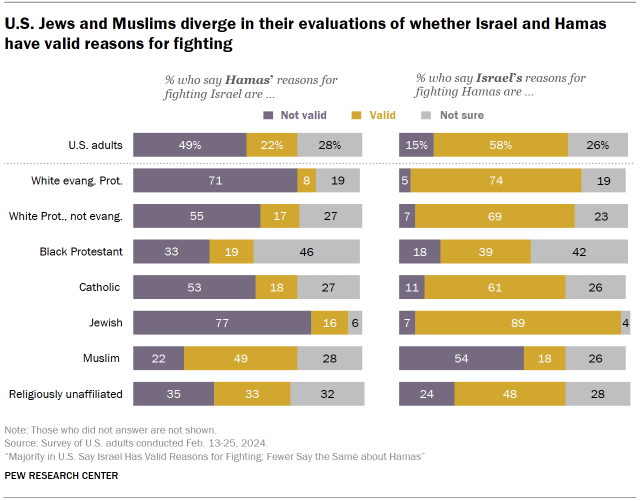
Americans’ emotional reactions to the war
In the U.S., 62% of Jews and 53% of Muslims report that hearing or reading news about the Israel-Hamas war makes them afraid. In other religious and nonreligious groups, the share expressing fear is lower. Jews are also more likely than other U.S. religious groups to say news about the conflict makes them feel angry.
American Jews and Muslims are also paying more attention to the war than other groups analyzed, with 61% of Jews and 41% of Muslims saying they’re following it extremely or very closely.
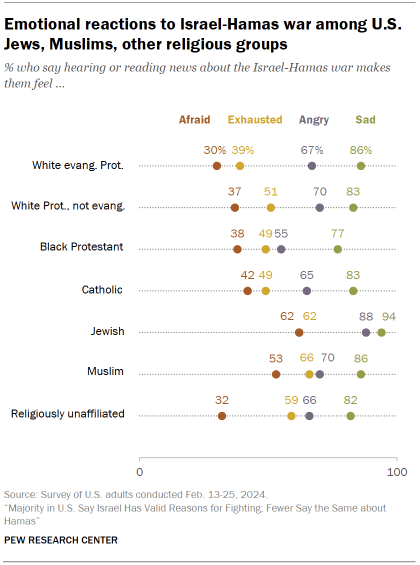
Pew Research Center surveys conducted on our American Trends Panel (ATP) always include Jews and Muslims. But these surveys do not always have enough Jewish or Muslim respondents to report their answers separately. This is because they make up relatively small shares of the U.S. adult population: Roughly 2% of Americans say their religion is Judaism , and 1% say their religion is Islam .
To provide more reliable estimates of Jewish and Muslim views on the topics covered in this survey, we included Jewish and Muslim respondents from three other national panels run by large research organizations (Ipsos, NORC and SSRS). All these panels are probability based, meaning they use random sampling methods to recruit respondents. They are not “opt-in” polls . In total, 1,941 Jewish and 414 Muslim respondents participated in this survey.
In this report, Jews and Muslims are defined as U.S. adults who answer a question about their current religion by saying they are Jewish or Muslim, respectively. Unlike our 2020 report on Jews in America , this report does not analyze the views of “Jews of no religion” (i.e., people who identify as Jewish culturally, ethnically or by family background but not by religion).
While the sample design was identical for Jews and Muslims, the resulting sample sizes are different. There are two main reasons for this. The Jewish population in the U.S. is roughly double the size of the Muslim population . Consequently, national survey panels have roughly twice as many or more Jewish panelists as Muslim ones. In addition, decades of research on survey nonresponse has shown that some groups in the U.S. are more likely to participate in surveys than others. Generally speaking, Jewish adults are more likely to participate in surveys than Muslim adults.
Views of how, why the war is being fought, by age
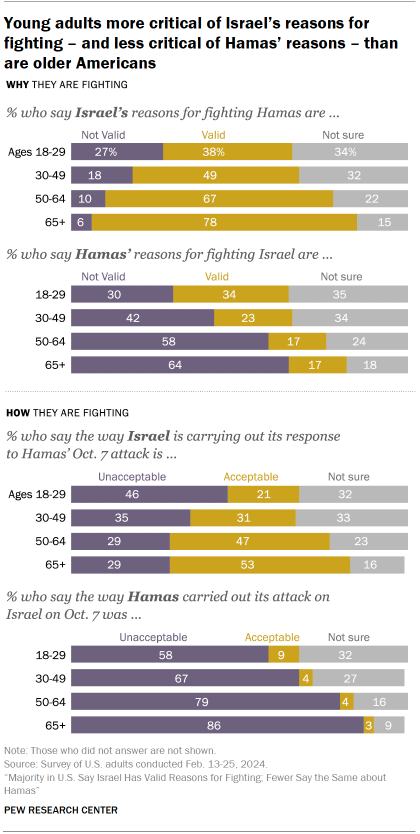
There are also stark differences across age groups in views of the war. For example:
- Roughly equal shares of adults under 30 say Hamas’ reasons for fighting Israel are valid (34%) and not valid (30%); 35% are unsure. By comparison, most of those ages 65 and older say Hamas’ reasons are not valid (64%).
- Younger adults are significantly more critical of how Israel is fighting in the war than are older people: 21% of Americans ages 18 to 29 say the way Israel is carrying out its response to Hamas’ Oct. 7 attack is acceptable; 46% describe it as unacceptable.
Age differences also are evident in many other issues related to the war, which are explored in other chapters of this report. Some key findings include:
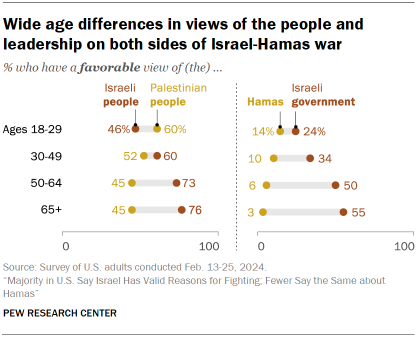
- More younger Americans express favorable views of the Palestinian people (60%) than of the Israeli people (46%). Relatively few have positive views of either the Israeli government (24%) or Hamas (14%). And, among Democrats and Democratic-leaning independents under 30, the Israeli government (16%) and Hamas (18%) are held in equally low esteem. (Explore more in Chapter 1 .)
- Younger adults are much less supportive of the U.S. providing military aid to Israel than are older people, but they’re also somewhat less in favor of the U.S. providing humanitarian aid to Gaza or playing a major diplomatic role in resolving the conflict. (Explore more in Chapter 2 .)
- Younger Americans are more likely than older adults to say the way the Israeli government is carrying out the war against Hamas will make the Israeli people less secure than they were before the war – though large shares across all age groups are unsure. (Explore more in Chapter 3 .)
- As with other international news events, the Israel-Hamas war appears to be drawing less attention from younger adults than from older people. Just 14% of those under 50 say they are following the war extremely or very closely, roughly half the share among those over 50 (30%). Consistent with their lower levels of attention, younger Americans are also less likely to know key facts about the ongoing war, based on their responses to three knowledge questions included on the survey. (Explore more in Chapter 4 .)
Related: How Americans view the conflicts between Russia and Ukraine, Israel and Hamas, and China and Taiwan
Where Americans’ sympathies lie
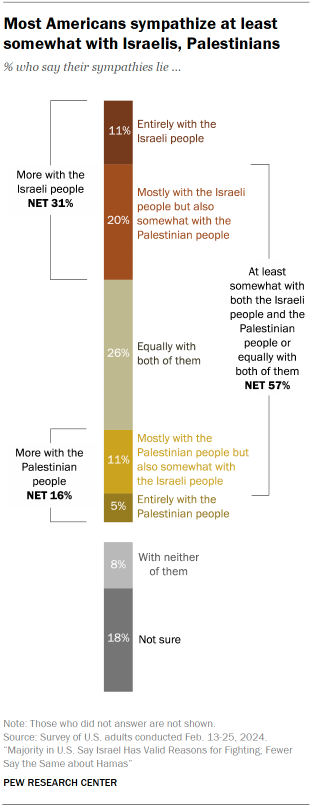
Few Americans say they sympathize entirely with either the Israeli people (11%) or the Palestinian people (5%). Rather, 57% sympathize at least to some extent with both Israelis and Palestinians, including 26% who say their sympathies lie equally with both groups.
A much smaller share of U.S. adults (8%) say they do not sympathize with either group, while 18% are unsure.
To the degree that Americans sympathize more with one group than the other, 31% say their sympathies lie either entirely or mostly with the Israeli people. This is about twice as many as say their sympathies lie either entirely or mostly with the Palestinian people (16%).
By a margin of more than 2-1, adults under 30 sympathize relatively more with Palestinians than with Israelis (33% vs. 14%), while the balance of opinion is reversed among older age groups.
Much of this is related to young Democrats and Democratic leaners, 47% of whom sympathize either mostly or entirely with Palestinians. Young Republicans and GOP leaners, on the other hand, are slightly more likely to sympathize either entirely or mostly with Israel (28%), or with both sides equally (24%), than entirely or mostly with Palestinians (12%). Substantial shares of both young Democrats (19%) and young Republicans (24%) say they are unsure where their sympathies lie.
Views of the people and leadership in the war
Americans tend to express much more favorable views of the people on both sides of the Israel-Hamas war than of the leadership on either side (the Israeli government, the Palestinian Authority and Hamas).
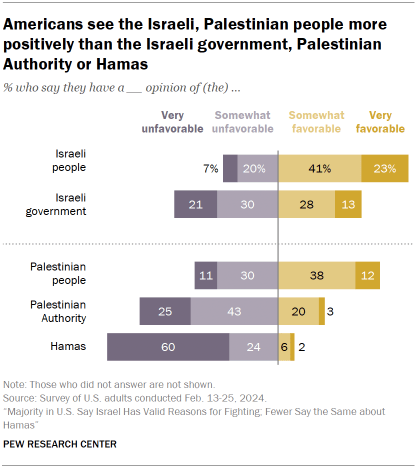
For example, 64% of U.S. adults say they have a favorable view of the Israeli people, compared with 41% who express a favorable view of the Israeli government.
The same is true of views of the Palestinian people (50% favorable) compared with either the Palestinian Authority, which controls the West Bank (23% favorable), and especially relative to Hamas, which has controlled Gaza in recent years (8% favorable). Indeed, six-in-ten Americans express very unfavorable views of Hamas.
Views of the Israeli government have become more negative since 2022. Today, 41% of U.S. adults express a favorable view of the Israeli government, down from 47%. The share who express very unfavorable views of the government also has nearly doubled over this time period, from 12% to 21%. (We do not have data on how views of the Palestinian Authority or Hamas have changed over time.)
Among adults under 30, the share expressing a favorable view of the Israeli people has fallen 17 percentage points since 2019, while their views of the Palestinian people have not shifted over this timespan. Older people’s views of both Israelis and Palestinians have remained largely unchanged.
How to describe the current war, both for the respondents taking the survey and when writing up the results, is not a choice we made lightly.
First, we consulted The Associated Press Stylebook , a resource we often follow. According to the AP Stylebook, “The Associated Press is calling the present conflict between Israel and the militant Palestinian group Hamas a war … Do not use terms such as Israel-Palestinian war or Gaza war.”
Second, we consulted with outside experts who recommended we avoid terminology suggesting that Israeli forces are fighting only in Gaza when, in reality, they are also active on other fronts, including against Hezbollah in Lebanon .
Third, we conducted pretests with 17 respondents and asked them, “Do you have thoughts on using the phrase ‘Israel-Gaza war’ instead of ‘Israel-Hamas war’?” While around half did not have an opinion, among those who did, several felt “Israel-Hamas war” was more accurate. For example, one respondent said, “It should be the Israel-Hamas war because it’s not a Gaza thing, it’s Hamas versus Israel. They started it.” Another noted, “I don’t agree with saying Israel-Gaza war. It’s Israel-Hamas. That’s who they are going after.” Still, two respondents said the opposite. One said, “It’s more Israel-Gaza than Israel-Hamas [because] it’s not really Jews against Palestinians, so we should focus on a country and that region.” Another said, “Gaza sounds bigger than the Hamas part does.” All 17 respondents said the questions we asked seemed neutral, rather than appearing to favor a particular side in the ongoing war.
After completing the survey, the 12,693 respondents who took it were also asked whether they found the survey to be politically neutral, and 92% did, including large majorities of Muslims and Jews.
What role do Americans think the U.S. should play?
Americans are divided about how – and whether – the U.S. should be involved in the Israel-Hamas war.
- More than twice as many Americans favor providing humanitarian aid to Gaza as oppose it (50% vs. 19%). About three-in-ten say they either have no clear preference or are not sure. (This question was asked before the United States began airdropping food and other supplies in Gaza and announced plans to build a temporary port to allow aid to arrive by sea .)
- Providing military support to Israel is much more divisive: 36% of Americans favor providing U.S. military aid to help Israel in its war against Hamas, while 34% oppose it. The remainder say they neither favor nor oppose military aid (14%) or are not sure (15%).
- Only 20% of Americans want the U.S. to play a major diplomatic role in resolving the Israel-Hamas war. Another 35% want the U.S. to play a minor role, while 27% prefer that it play no role at all.
Democrats and Democratic-leaning independents differ sharply from Republicans and Republican-leaning independents in their attitudes toward U.S. involvement in the war.
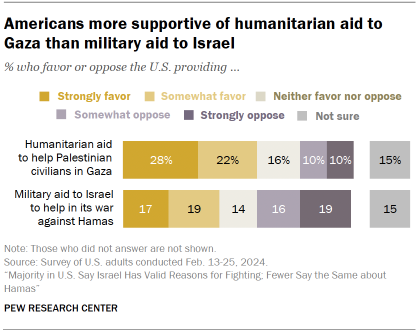
Democrats are much more supportive than Republicans of providing humanitarian aid in Gaza (66% vs. 35%) and of the U.S. playing a major diplomatic role in resolving the war (25% vs. 16%).
Indeed, Republicans are twice as likely to say the U.S. should play no role (32%) as they are to say the U.S. should play a major role (16%) in solving the conflict; 37% support the U.S. playing a minor role. However, Republicans are twice as likely as Democrats to favor providing military aid to Israel to help in its war against Hamas (50% vs. 25%).
Do Americans think Biden is striking the right balance?
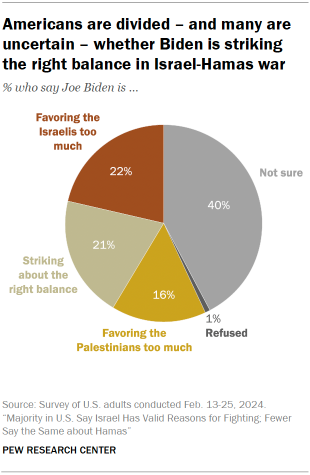
U.S. public opinion is deeply divided – and to a large extent uncertain – about whether President Joe Biden is striking the right balance in his approach to the war (21%), favoring the Israelis too much (22%) or favoring the Palestinians too much (16%). The largest single slice of the public –40% – is not sure how well Biden is handling the issue.
While these views are broadly similar to what we found in a December 2023 Pew Research Center survey , opinion among those under 30 has shifted. In the February survey, 36% of those ages 18 to 29 say Biden is favoring Israel too much, up from 27% just a few months ago. (Explore this further in Chapter 2 .)
American Jews stand out for the relatively high share who say Biden is striking the right balance (45%). Only around a quarter or fewer in most other religious groups say the same, including just 6% of U.S. Muslims. Muslims are among the U.S. religious groups that are most inclined to say Biden favors the Israelis too much (60%). Among other religious and nonreligious groups, atheists (52%) and agnostics (43%) are especially likely to express this view.
What’s next? Americans’ views on a long-term resolution to the war

One of the few opinions a solid majority of Americans can agree on when it comes to the Israel-Hamas war is that lasting peace is unlikely. Only 3% say it is either extremely or very likely, while 9% say it’s somewhat likely. Fully 68% say a lasting peace between Israelis and Palestinians is either not too or not at all likely.
Opinion is somewhat more mixed when it comes to the best possible outcome of the conflict. A plurality (40%) says the best outcome would be a two-state solution – splitting the land into two countries, one with an Israeli government and one with a Palestinian government. But many Americans remain unsure of the best outcome (30%), and some prefer a model in which all the land is one country with an Israeli government (14%) or one country that is jointly governed by Israelis and Palestinians (13%). Few prefer the land to be one country with a Palestinian government (2%).
Jewish Americans (46%) and Muslim Americans (41%) also tend to think a two-state solution is the best possible outcome, but about one-in-five people in each group support a one-state option. Among Jews, 22% would prefer for all the land to be one country with an Israeli government. Among Muslims, 20% would like all the land to be under a Palestinian government.
Overall, Americans’ support for a two-state solution has increased modestly since 2022 , from 35% to 40%. Much of the shift has come among Democrats and Democratic-leaning independents. Today, 48% of Democrats favor a two-state solution, up from 36% in 2022. Indeed, this shift has opened up a partisan gap in views of the two-state solution that was not present in 2022.
Among Republicans, the two-state solution is endorsed by 33%, while 26% think the best outcome would be for a single country, with an Israeli government, to control all the land. (Explore this further in Chapter 3 .)
- Although only some religious subgroups are analyzed in this report, the survey included respondents of many other religious backgrounds, including members of the Church of Jesus Christ of Latter-day Saints (widely known as Mormons), Hindus and Buddhists. But there are not enough respondents from these smaller groups to report on their answers separately. ↩
Sign up for our weekly newsletter
Fresh data delivered Saturday mornings
Report Materials
Table of contents, how americans view the conflicts between russia and ukraine, israel and hamas, and china and taiwan, americans’ views of the israel-hamas war, comparing views of the u.s. and china in 24 countries, views of india lean positive across 23 countries, international views of biden and u.s. largely positive, most popular.
About Pew Research Center Pew Research Center is a nonpartisan fact tank that informs the public about the issues, attitudes and trends shaping the world. It conducts public opinion polling, demographic research, media content analysis and other empirical social science research. Pew Research Center does not take policy positions. It is a subsidiary of The Pew Charitable Trusts .

IMAGES
VIDEO
COMMENTS
The Library of Congress is uniquely prepared to tell the story of the United States' participation in the Great War. The Library's unparalleled collections include posters, recordings, newspapers, sheet music, photographs, and veterans' stories as well as publications, exhibitions, educational tools, and research guides related to World War I.
Assassination of Archduke Franz Ferdinand as the starting point of WW1. Naval warfare of World War I. Ottoman Empire in World War 1. The role of technology in World War 1. The use of chemical weapons in WWI. The most cruel war crimes of WW1. Armenian genocide as a part of World War 1.
World War I started in 1914, after the assassination of Archduke Franz Ferdinand, and ended in 1918. During the conflict, the countries of Germany, Austria-Hungary, Bulgaria and the Ottoman Empire ...
The following pages contain informative but concise summaries of key topics relating to World War I. These topic pages have been written by Alpha History authors. If you would like to contribute or suggest a topic for inclusion on this site, please contact us. An introduction to World War I
Suggested Essay Topics. Previous. 1 . What is trench warfare, and why was so much of World War I dominated by this method of fighting? Consider such elements as technology, strategy, attitudes of leaders, and any other factors you can think of. How did trench warfare affect the duration of the war? 2 . After the war, Germany was punished much ...
World War I was one of the great watersheds of 20th-century geopolitical history. It led to the fall of four great imperial dynasties (in Germany, Russia, Austria-Hungary, and Turkey), resulted in the Bolshevik Revolution in Russia, and, in its destabilization of European society, laid the groundwork for World War II.. The last surviving veterans of World War I were American serviceman Frank ...
Aided by the United States, the Allies finally broke through with the Hundred Days Offensive, leading to the military defeat of Germany. The war officially ended at 11:11 a.m. on November 11, 1918 ...
The digital collections of the Library of Congress contain a wide variety of material related to World War I, including posters, photographs, manuscripts, newspapers, films, sheet music, and sound recordings. This guide compiles links to World War I resources throughout the Library of Congress website. In addition, this guide provides links to ...
A hundred years ago, in mid-August 1920, a decisive battle took place in Central Europe between two sizable armies waging fierce combat operations in the region for more than a year. In the immediate aftermath of the Battle of Warsaw (as it was later termed by historians) the 950,000 troops of Soviet Russia were forced to retreat from the ...
The causes of World War I remain a topic of enormous intellectual interest. Yet, despite the immensity of the literature, historiographical and IR debates remain mired within unhelpful methodological dichotomies revolving around whether a 'primacy of foreign policy' versus 'primacy of domestic politics' or systemic versus unit-level approach best account for the war's origins.
WW1 Research & Sources of Information. The Great War of 1914-1918 is a vast subject. Listed here are links to our pages or external links to websites covering some of the more specialist areas of World War 1 archives and resources for research. You will find information on a variety of resource material for research on this subject including ...
World War I was fought from 1914 to 1918. Learn more about World War I combatants, battles and generals, and what caused World War I. Shows This Day In History Schedule Topics Stories
Time is arrested in Gail Jones' beautiful new novel of war and art, Salonika Burning. Tanya Dalziell, The University of Western Australia. Salonika Burning, set on the first world war's ...
Sometimes it can be overwhelming to come up with a topic and research question on your own. Here are some tips to help: 1. Develop a tentative focus. List what you know and want to know about a particular topic. Look at the questions that are most interesting to you. 2. Find background information on your topic.
Gun crew from Regimental Headquarters Company, 23rd Infantry, firing 37 mm gun during an advance on German entrenched positions. View in Catalog. As the largest repository of American World War I records, the National Archives invites you to browse the wealth of records and information documenting the U.S. experience in this conflict, including photographs, documents, audiovisual recordings ...
The prominent examples are Iran and Turkey. Impacts on Women's Role After World War I. The demographic, economic, social, and political impacts on women included voting rights, access to education, and better jobs, and changing of women's positions in society. World War I as a Total War.
9. Tanks are one of the most significant weapons to emerge from World War I. Investigate and discuss the development, early use and effectiveness of tanks in the war. 10. The Hague Convention outlined the 'rules of war' that were in place during World War I. Referring to specific examples, discuss where and how these 'rules of war' were ...
This Library of Congress collection features a collection of war-themed postal cards produced during World War 1 (1914-1919). The Stars and Stripes: The American Soldiers' Newspaper of World War I. The newspaper's mission was to provide scattered troops with a sense of unity and an understanding of their part in the overall war effort.
In the decades before the First World War, vast scientific and technological changes altered the face of the globe. Those changes had immense implications for the world's military institutions. The invention of the internal combustion engine, nitroglycerine, smokeless power, barbed wire, the telephone, and medical advances had all changed the civilian world and seemed to have major ...
World War I Poetry: Topics in Chronicling America. ... the poetry of World War One soldiers captures not only the last moments of someone's life but an entire lost generation. ... important dates related to this topic and a section of this guide provides some suggested search strategies for further research in the collection. Timeline. March ...
The War to End all Wars. World War I was a war that the world never thought would happen and certainly assumed could never happen again. Technology was booming, which changed the way fighting was ...
Research & Subject Guides; World War I - The Great War; Databases; Search this Guide Search. World War I - The Great War ... World War One. WW I . WWI . Other Possible Keywords/Subject Headings. The War to End All Wars. ... The Military Database covers topics across all government and military branches, including international relations ...
Start Your Research You may first want to search the WW1 Draft registration cards for basic information on individuals (see Draft cards section below). Nearly all men between the ages of 18-45 registered during the years the draft was implemented, about 23% of the U.S. population. If you are interested in researching military service records, this article will provide you with a good overview ...
On many questions about the war, sizable numbers express no opinion. These and other results come from a new Pew Research Center survey, conducted Feb. 13-25, among 12,693 adults. Unlike most polling in the United States since the war began, this survey includes enough Jewish and Muslim respondents to allow their views to be analyzed separately.
The latest results are from a March 1-20 survey. The Israel-Hamas war has continued for five months and has resulted in the deaths of tens of thousands of Palestinians and over 1,000 Israelis. ... Subscribe to the Front Page newsletter for weekly insights on the world's most pressing topics. (*) Required ... Our global research tracks human ...